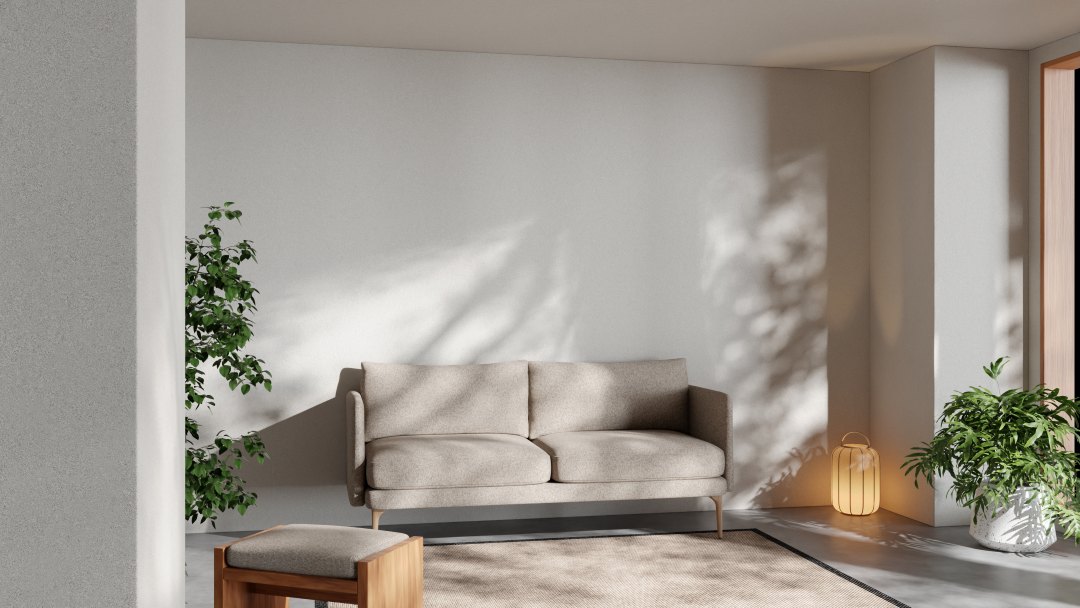Imagine walking into a space and finding yourself thinking, “Wow, this feels like a Pinterest board come to life,” or maybe, “This is exactly the kind of peace I want in my own home”.
As a premier interior design company in KL, Studio Pandan knows that such moments happen when a strong interior design concept is at play—one that knows exactly what it’s trying to achieve.
Interior design concepts are more than just styles; they’re strategies. They shape how a space feels, functions, and flows.
What looks impressive in a New York loft might not suit a terrace house in Shah Alam. A sleek Scandinavian home might look stunning in photos, but how do you make it practical for our tropical climate and local lifestyle?
That’s where the right interior design concept makes all the difference. When thoughtfully applied, it can transform any space into something truly special, not just beautiful, but also liveable, practical, and full of personality.
In this guide, we’re diving into over 10 global and local interior design styles — from minimalist Muji interior design to traditional Malaysian charm. Whether you’re exploring ideas or planning your next home renovation service, you’ll find inspiration and clarity to help shape a space that truly reflects your vision. Let’s dive in.
Types of Interior Design Concepts
There’s no one-size-fits-all when it comes to interiors, and with so many design styles out there, making the right choice can feel overwhelming. But that’s also what makes interior design so exciting: every space has a story to tell, and every design concept gives that story a distinct voice.
To help you find the perfect fit, we’ve broken down popular interior design concepts and thoughtfully grouped them by mood and function, so designing your space feels a little less daunting and a lot more inspiring.
Modern and Urban Living
1. Contemporary
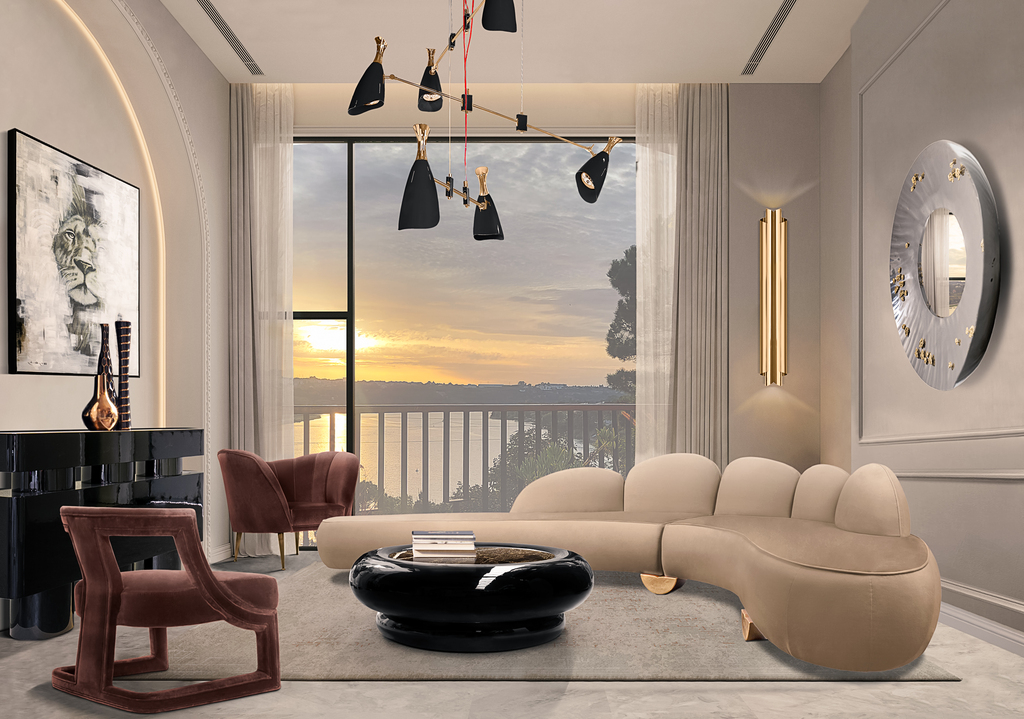
Contemporary interior design is all about flexibility and staying refreshingly in the moment. Rather than following a fixed aesthetic or historical period, it constantly evolves to reflect current trends, innovations, and cultural shifts.
Think of it as a style that moves with the times, defined by clean lines, open layouts, mixed materials, and smart, minimalist details that feel both timeless and fresh.
Whether in an urban apartment or a new development, contemporary interiors are airy, intuitive, and polished, perfect for those who value clarity, balance, and effortless sophistication through residential interior design service.
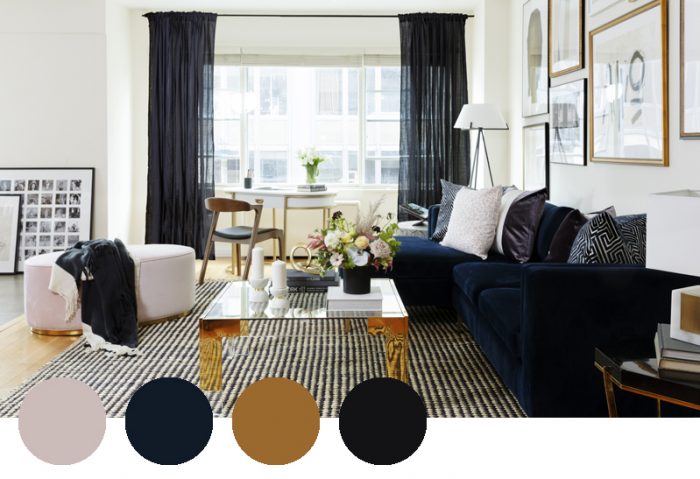
This design has a distinctive look and feel, defined largely by its thoughtful use of colour palettes and materials. These core elements work together to create spaces that feel current, elegant, and adaptable to changing trends.
Elements | Description |
Palette | Starts with neutrals such as white, beige, taupe, grey, and black, and is often punctuated by bold accents like forest green, rust, or navy. Trends may introduce jewel tones, earthy hues or pastels. |
Materials | Mix of polished and raw: timber, concrete, chrome, brushed brass, glass. Think a velvet sofa on concrete floors or brass lighting over sleek cabinetry. |
Texture and Shape | Contrast reigns — soft meets structured, matte meets gloss. Furniture often features subtle curves or geometric forms. |
Lighting | Layered lighting is key. Recessed lights, sculptural pendants, and strategic uplighting define and elevate the space. |
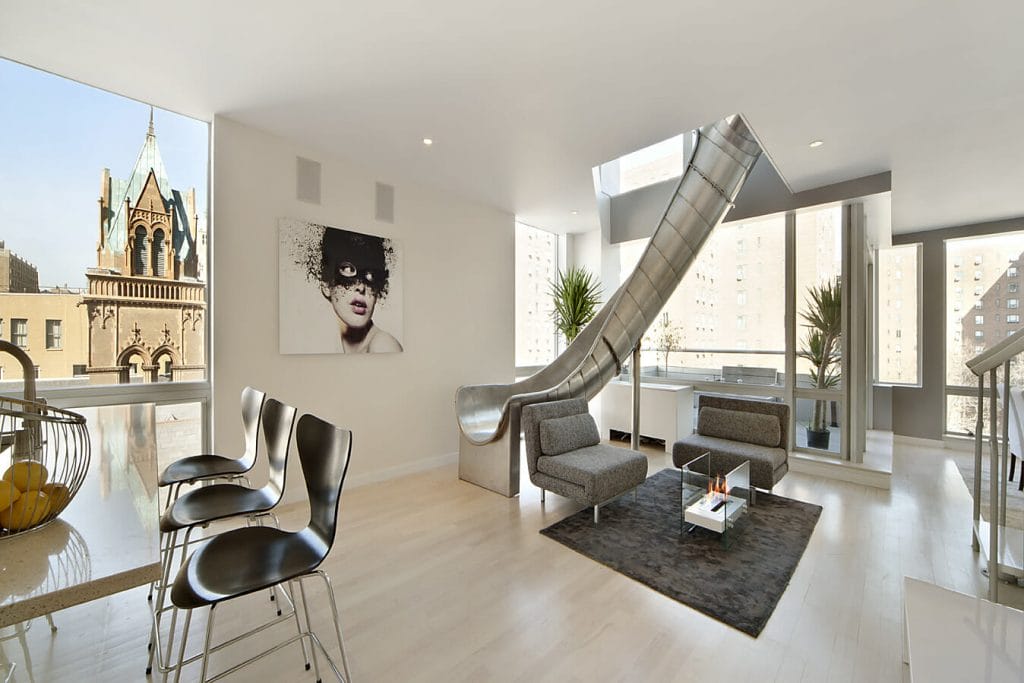
Contemporary design resonates with those who value adaptability, fresh aesthetics, and a space that evolves with the times. It’s ideal for homeowners drawn to clean lines, thoughtful trends, and interiors that feel current yet timeless.
Malaysian Contemporary Interior Design by Studio Pandan
Studio Pandan’s take on contemporary interiors blends modern function with visual warmth. Through clean lines, layered lighting, and curated materials, their spaces feel sleek, refined, and effortlessly liveable.
Contemporary Bedroom

This bedroom, designed for a high-rise condo, embodies contemporary minimalism with a Malaysian touch and thoughtful functionality. Warm timber flooring brings organic richness and grounds the space, while soft, neutral-toned linens and tailored blackout curtains strike the perfect balance between comfort and calm.
Thanks to the unit’s high-floor location, full-height blinds allow natural light to flood in without compromising privacy, keeping the room bright and airy. A built-in desk with overhead cabinets maximises vertical storage, maintaining a clean, uncluttered layout, ideal for a compact condo footprint.
Contemporary Kitchen
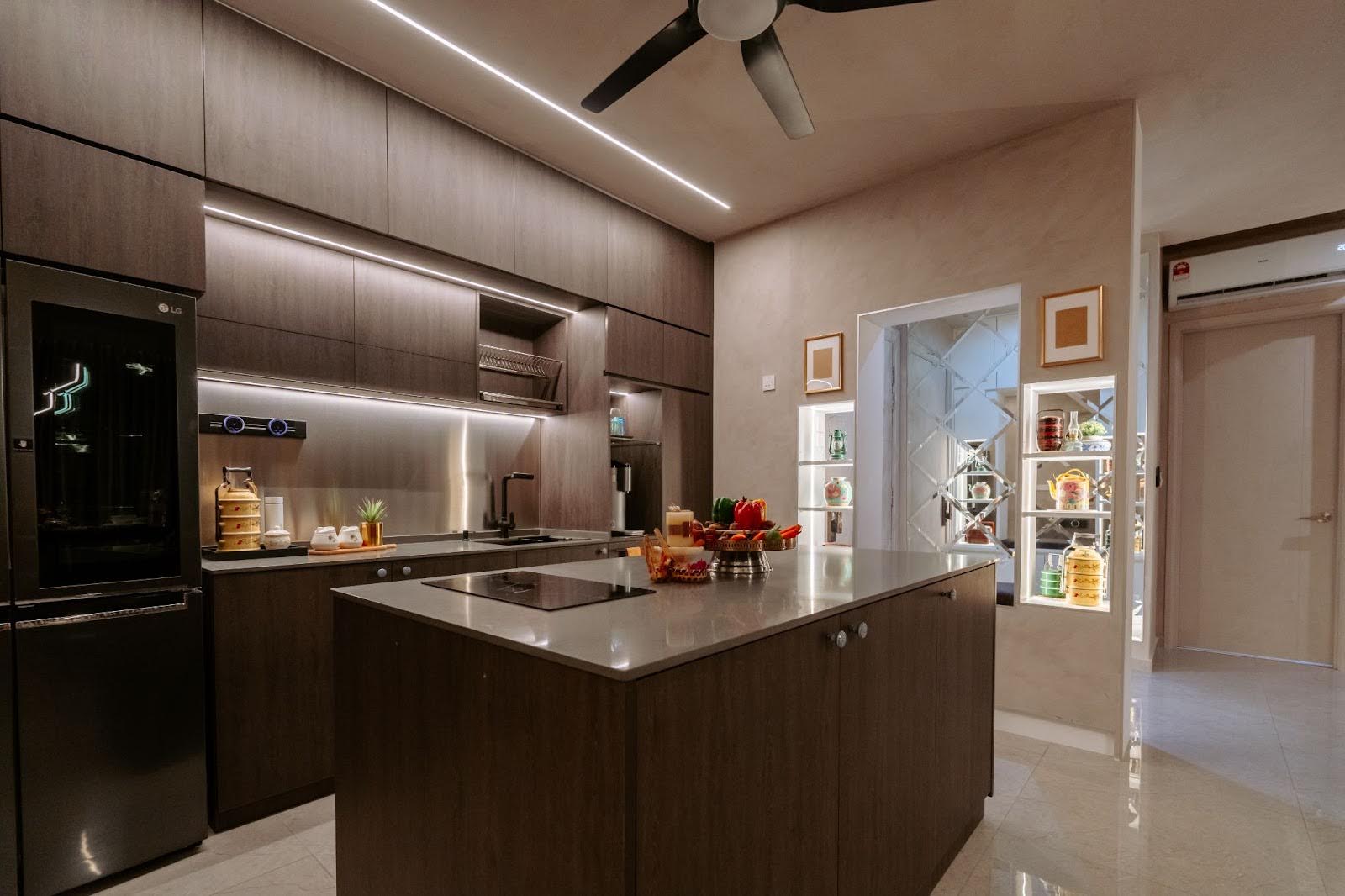
Designed for light daily cooking and a smooth workflow, this kitchen transforms a previously inefficient peninsula layout into a sleek island setup that adds both prep area and social functionality.
Matte dark cabinetry contrasts against a stainless-steel backsplash, while soft strip LED lighting beneath cabinets keeps the space feeling bright without glare. Proportional cabinetry creates symmetry, and the central island serves as a practical yet elegant focal point.
Contemporary Living Area
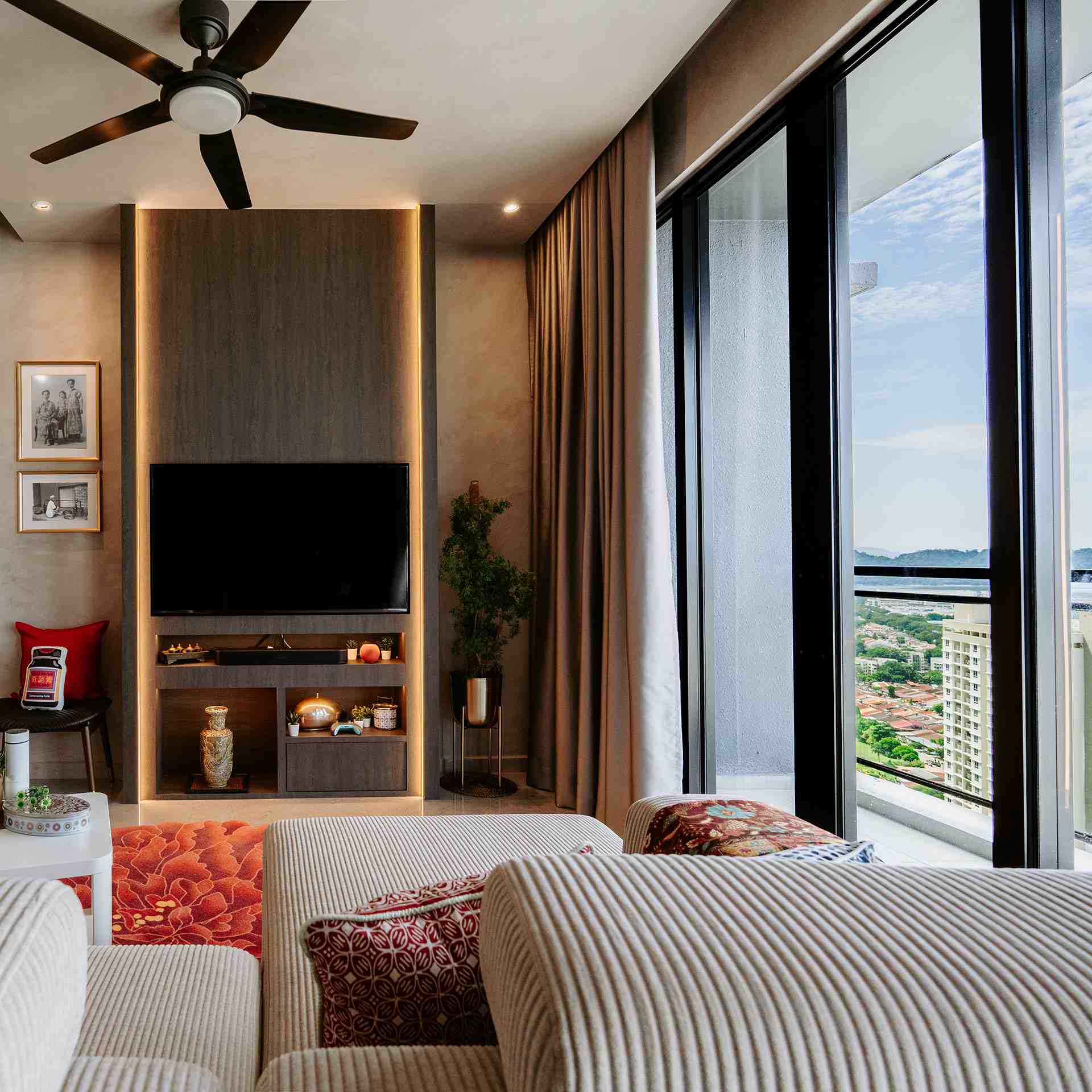
With its compact footprint, this living area delivers a significant impact through smart modular furniture and strategic layering. A ribbed-texture sofa provides both comfort and versatility, adapting to solo lounging or entertaining.
The floor-to-ceiling sliding glass doors dramatically expand the sense of space, connecting indoors to sweeping urban views, while built-in storage around the TV wall keeps things clean and cohesive, perfect for a Muji design living room. Earthy accents, local artwork, and curated decor bring warmth without clutter.
2. Modern
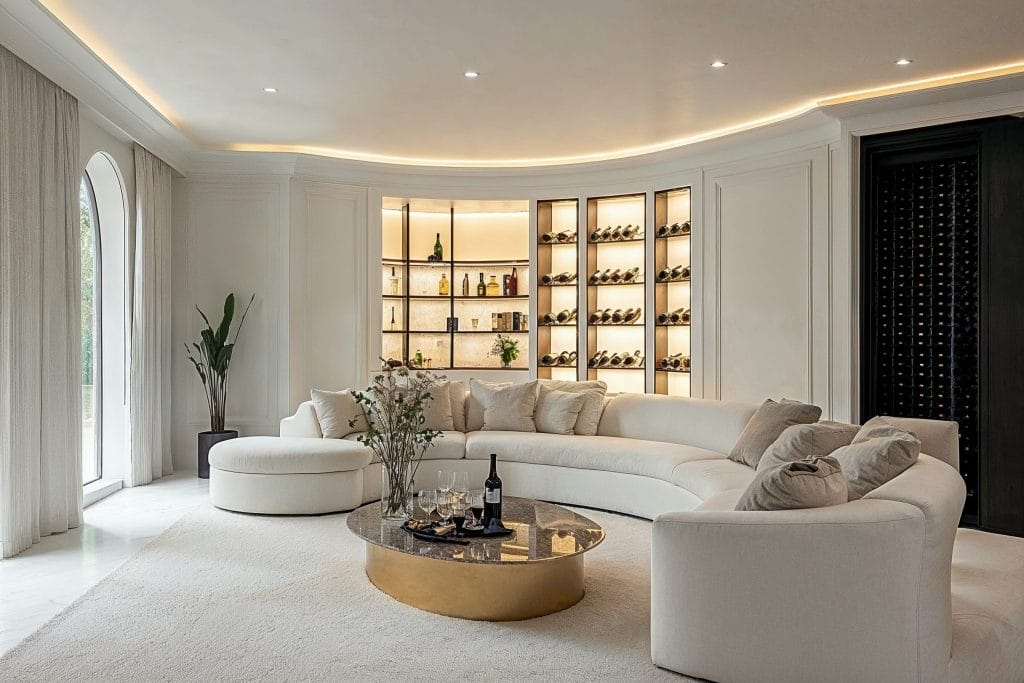
Isn’t modern and contemporary design the same thing? Not quite. Sure, they both love clean lines, cool vibes, and simplicity, but look a little closer and you’ll see they have distinct personalities. Modern style is less trend-driven and more rooted in timeless structure and purpose.
Modern interiors are all about clean, clever, and functional design. Originating in the early to mid-20th century, this style emphasises simplicity, streamlined forms, and the intentional use of space, all guided by the principle that design should be purposeful.
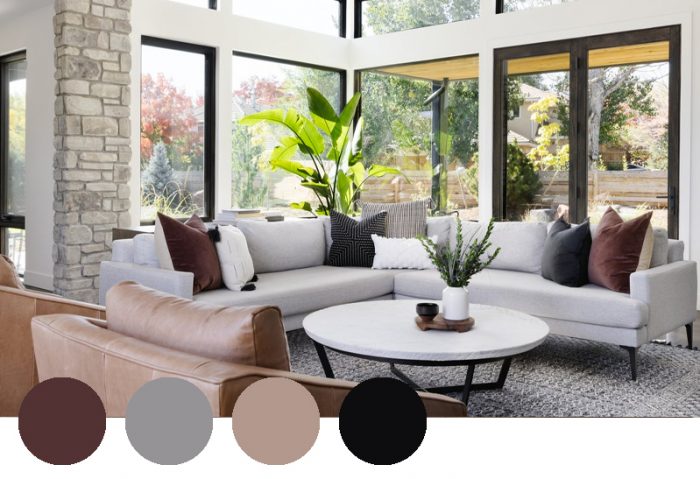
Modern design thrives on functionality without fuss. Every element, from furniture to finishes, is purposeful, pared-back, and precise. The result? Calm, cohesive spaces with a confident sense of order.
Elements | Description |
Palette | A foundation of whites, greys, taupes, and blacks, complemented by accent tones like olive, ochre, navy, or terracotta. Colour is minimal, but impactful. |
Materials | Emphasis on natural and industrial materials, including warm wood, steel, glass, leather, and concrete. Smooth, matte surfaces and minimal embellishments. |
Texture and Shape | Clean lines and geometric forms. Tapered legs, cantilevered silhouettes, and flat-front cabinetry reinforce the functional feel. |
Lighting | Prioritises natural light with large windows. Fixtures are subtle and architectural, think recessed lighting, metal pendants, and unobtrusive floor lamps. |
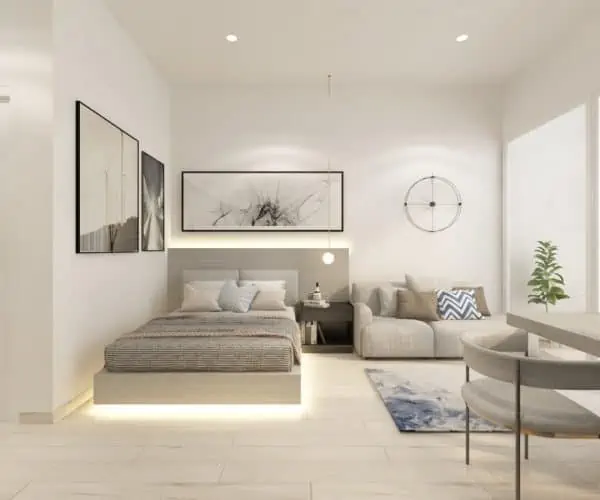
Modern design resonates with those who value structure, clarity, and understated elegance. It appeals to homeowners drawn to timeless aesthetics, purposeful spaces, and a sense of calm through simplicity.
3. Industrial
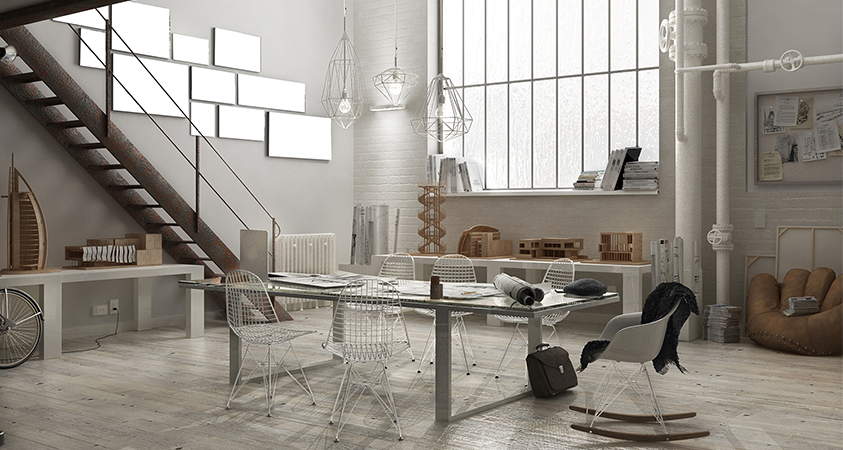
Industrial interior design draws from the utilitarian charm of old factories, converted warehouses, and urban lofts. It’s a style that celebrates the raw and rugged, where exposed brick, visible pipes, concrete floors, and metal fixtures aren’t flaws, but standout features.
Rooted in authenticity, Industrial design is bold and unapologetically unpolished. It thrives on contrast and texture, where rough meets refined and vintage blends with modern. Open spaces, unfinished surfaces, and honest materials turn everyday utility into cool, considered design.
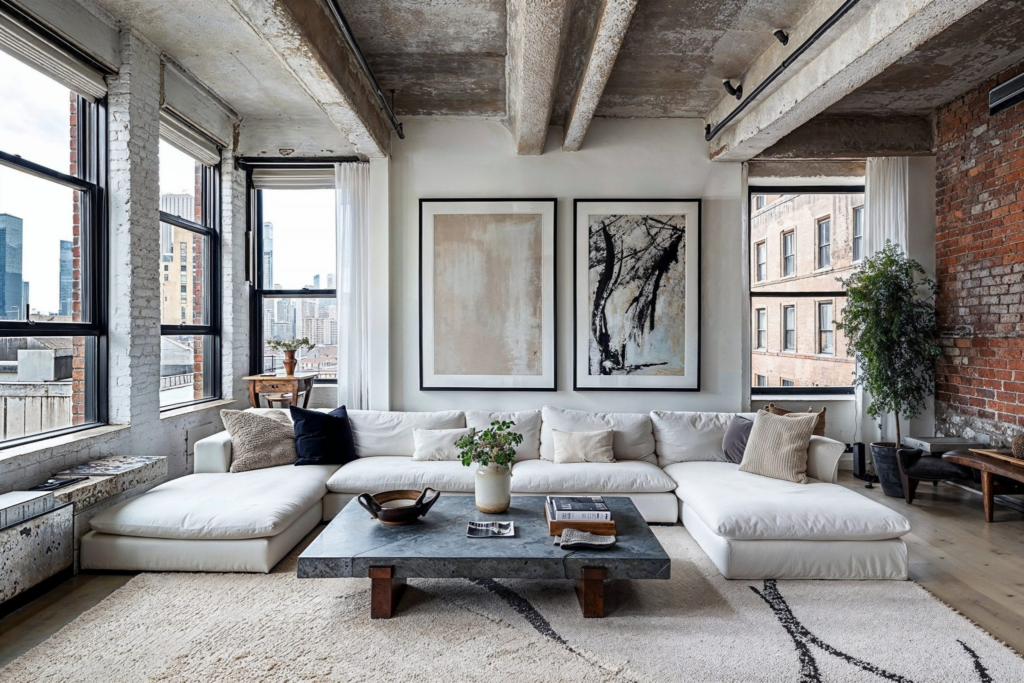
Industrial design is all about revealing a building’s bones and celebrating the beauty of age, wear, and structure. Spaces feel open and unfussy, filled with texture, grit, and a grounded, architectural presence.
Elements | Description |
Palette | A base of greys, blacks, and whites, warmed with earthy browns and rust tones. Accent colours like oxblood, navy, and deep neutrals add depth without disrupting the raw feel. |
Materials | Concrete, brick, reclaimed wood, steel, iron, leather, and matte glass. Surfaces are distressed, unfinished, or weathered — nothing overly polished or pristine. |
Texture and Shape | Expect contrast: rough concrete meets soft leather; smooth steel with aged wood. Shapes are often boxy or industrial, characterised by straight lines, solid forms, and metal frames. |
Lighting | Statement factory-style fixtures: metal pendants, cage sconces, exposed bulbs. Lighting adds drama and reinforces the utilitarian vibe. |
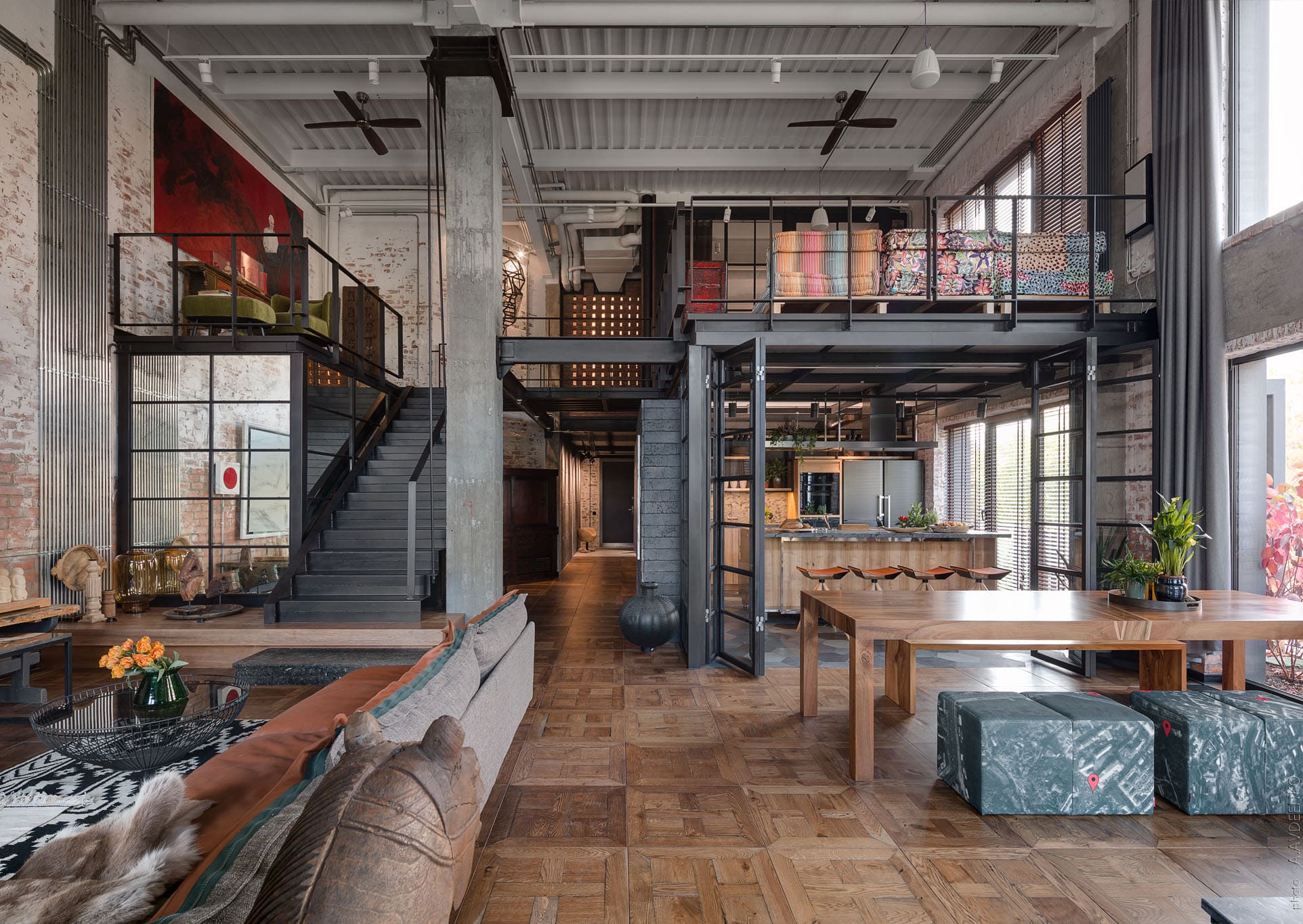
Industrial design resonates with those who appreciate raw character, bold structure, and a sense of unpolished charm. It appeals to urban dwellers craving that loft-like edge, creatives who value grit and expression, and anyone drawn to strong, story-driven spaces.
4. Transitional
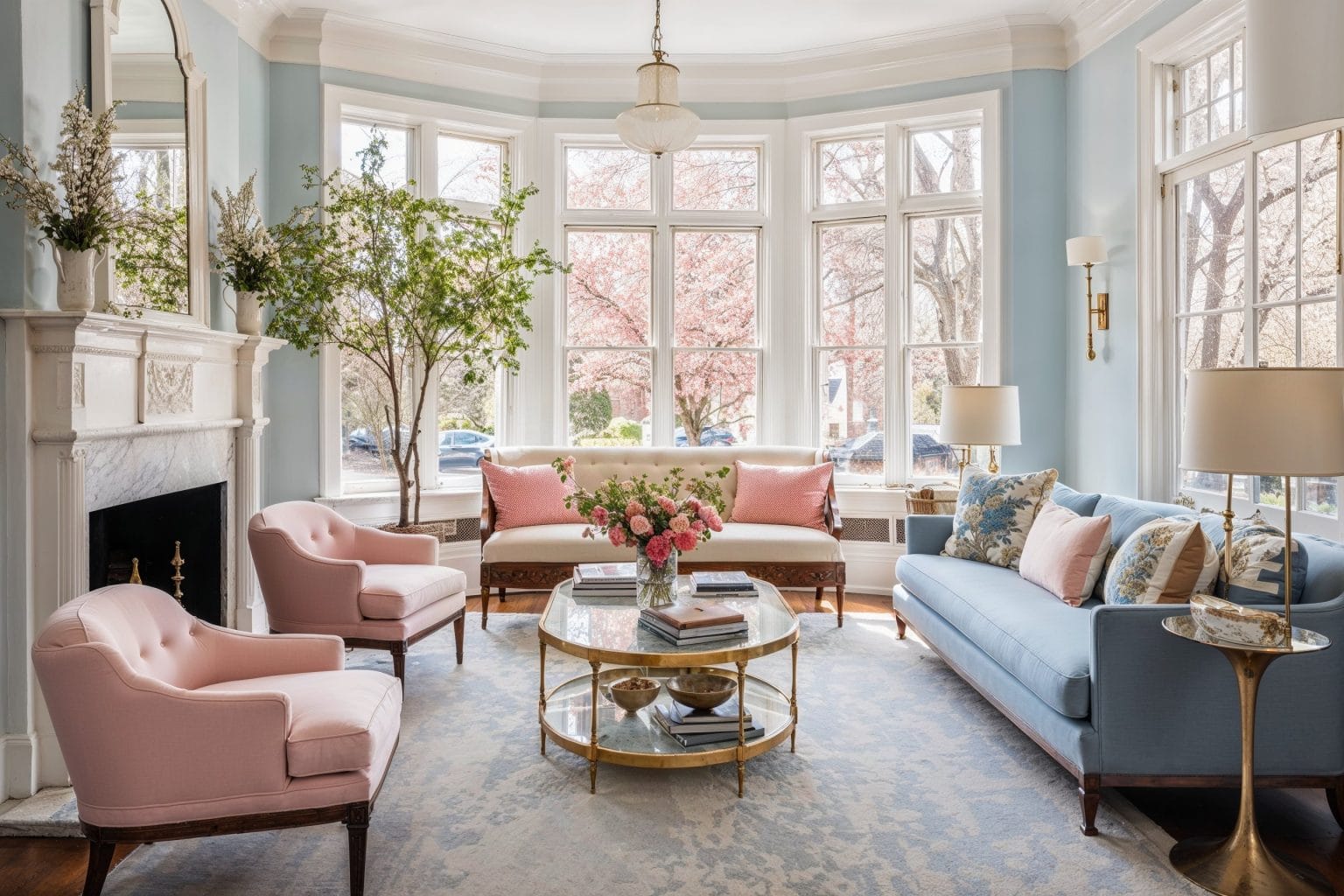
If you love traditional design but don’t want your space to feel stuck in the past, then Transitional interior design is for you. This style strikes a thoughtful balance between classic elegance and modern simplicity.
It brings together the warmth of traditional elements with the clean lines and functionality of contemporary aesthetics, creating spaces that feel timeless, tailored, and liveable. Rather than leaning too far in either direction, Transitional design finds harmony between the ornate and the minimal, the structured and the soft.
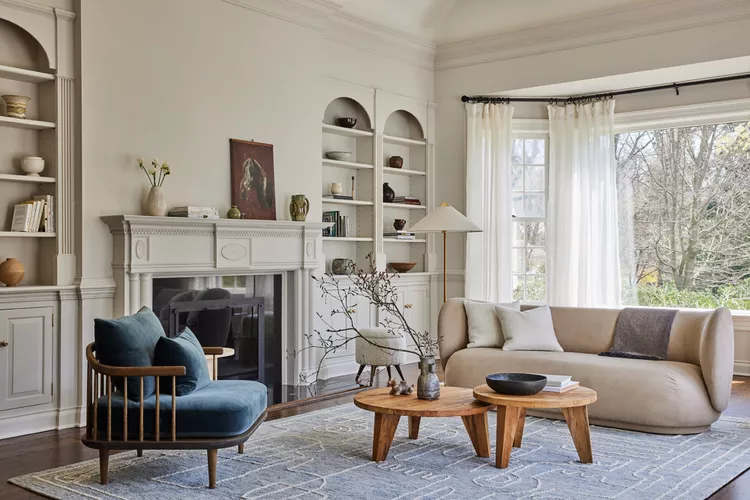
Transitional interiors feel curated and calm. You’ll find classic silhouettes updated with modern fabrics, traditional architecture paired with streamlined décor, and a focus on neutral tones that create a sense of continuity.
Elements | Description |
Palette | Soft, neutral tones like beige, ivory, taupe, and warm greys set a serene foundation. Accents in muted blues, greens, or deep browns offer subtle contrast. |
Materials | A mix of traditional and modern: polished wood, brushed metal, natural stone, leather, and soft upholstery. Texture adds depth without visual noise. |
Texture and Shape | Clean-lined furniture with classic curves. Layered textiles, tailored drapes, and simple mouldings balance comfort and structure. |
Lighting | A mix of classic fixtures and modern forms — think drum chandeliers, clean-lined sconces, and glass or metal pendants that bridge old and new. |
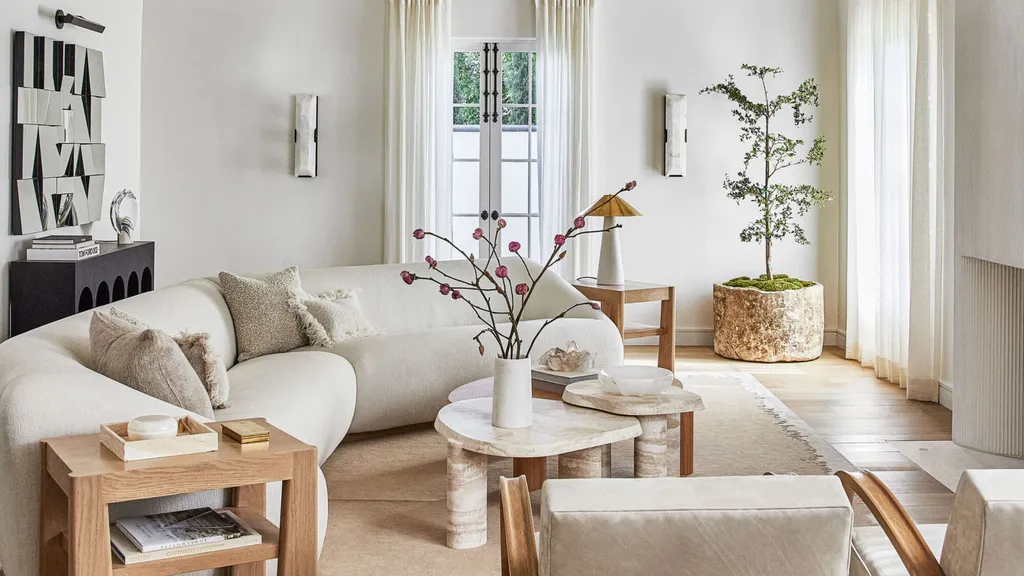
Transitional design resonates with those who want the best of both worlds: timeless charm with a modern sensibility.
It’s ideal for homeowners seeking a space that’s warm, inviting, and effortlessly balanced. Whether you’re updating a classic home or softening a modern build, Transitional style offers flexibility, comfort, and enduring appeal.
Want a Muji-inspired home without the designer price tag? Check out our budget-friendly Muji interior guide.
5. Mid-Century Modern

Mid-Century Modern interior design is iconic, timeless, and effortlessly stylish. Emerging between the 1940s and 1960s, this style blends clean lines with gentle curves, striking a balance between organic warmth and industrial innovation.
Influenced by Scandinavian and Bauhaus principles, it champions function, simplicity, and a futuristic optimism that still feels fresh today. Open layouts, sculptural forms, and a connection to nature are central. From Eames chairs to Sputnik lighting, this era’s design legacy is built on quality craftsmanship and enduring appeal.
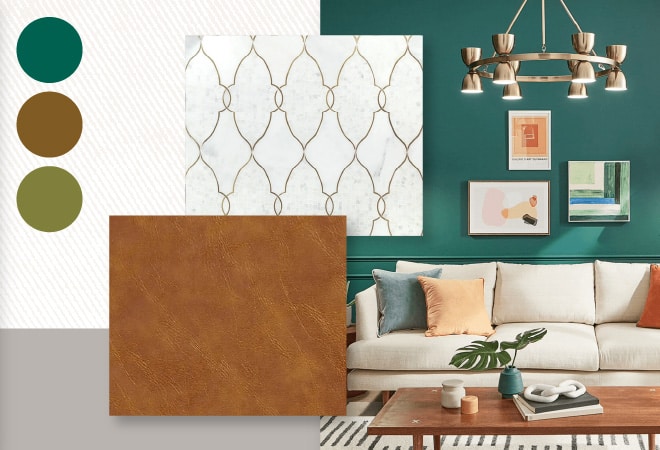
Mid-Century Modern interiors are inviting, practical, and full of personality. The look is polished yet relaxed, a balance of form and function with just the right touch of vintage flair.
Elements | Description |
Palette | Warm woods (walnut, teak) set the tone, paired with soft neutrals like off-white and grey. Earthy hues (mustard, olive, rust) and vibrant accents (turquoise, red, aqua) bring personality. |
Materials | Natural and man-made: polished wood, leather, brushed metal, fibreglass, glass, and textured textiles. Surfaces are clean and refined with an emphasis on quality and craftsmanship. |
Texture and Shape | Mix of organic curves and geometric forms. Furniture is low-slung with tapered legs; sculptural lighting and retro prints add visual interest. |
Lighting | Statement pieces shine — globe pendants, arc lamps, and Sputnik chandeliers all add sculptural drama and a hint of space-age flair. |
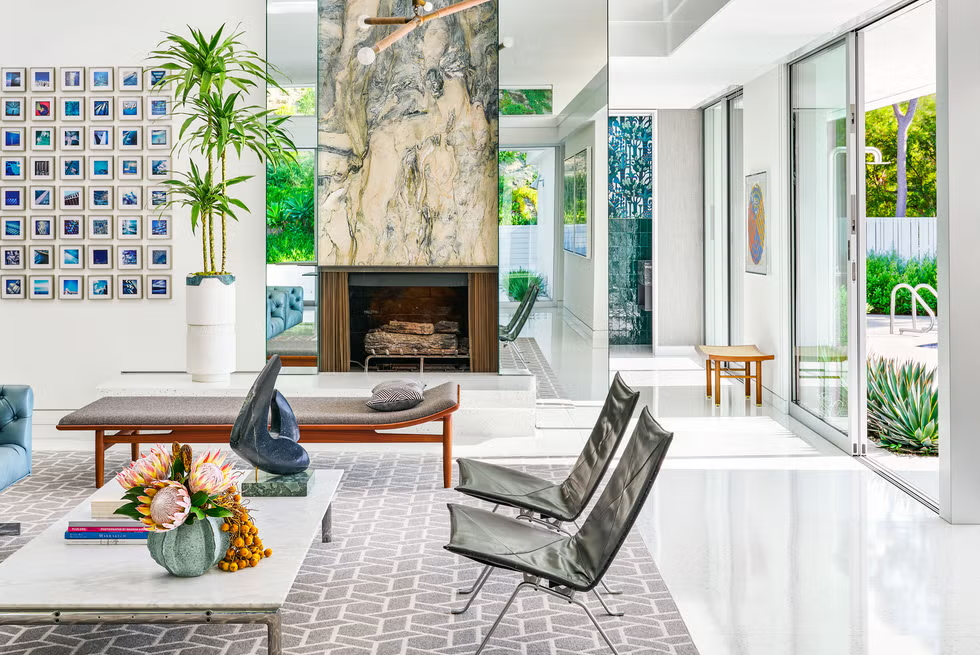
Mid-Century Modern design resonates with those who appreciate vintage charm, timeless craftsmanship, and purposeful design. It’s a favourite among homeowners, creatives, and renovators who value bold forms, warm materials, and curated simplicity.
6. Eclectic
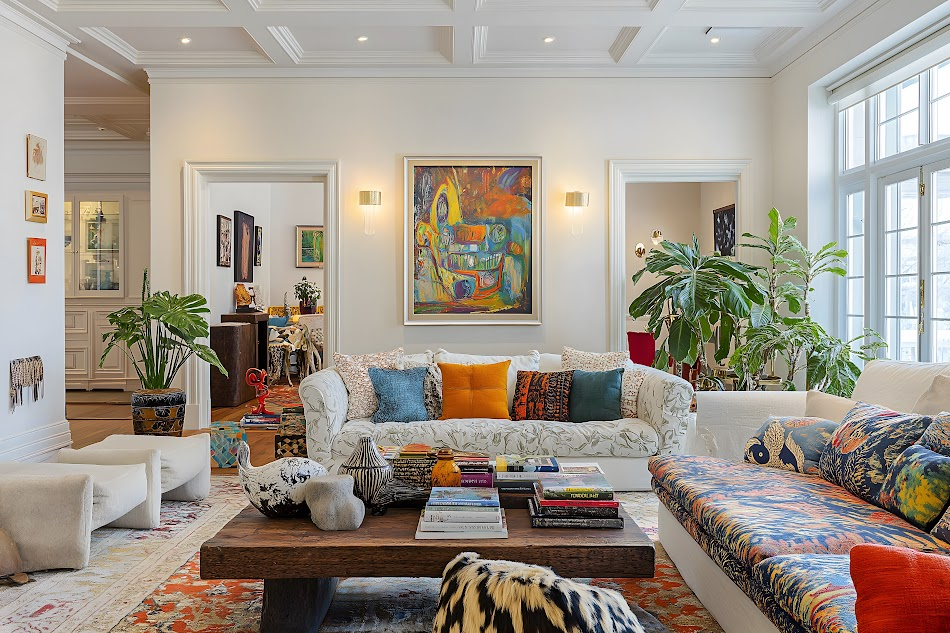
Eclectic interior design is the art of curated contrast, mixing styles, eras, and textures to create a space that’s rich in personality and visual storytelling. Rather than following a single rulebook, Eclectic spaces borrow from many influences, tied together by intentional choices and a confident eye for balance.
It’s not about chaos, it’s about thoughtful curation. A unifying colour palette, a repeated material, or a shared motif keeps everything cohesive, regardless of how diverse the pieces are. The result is a home that feels layered, lived-in, and entirely unique.

Eclectic design invites individuality and creativity. It’s about telling your story through objects, styles, and moments — all artfully mixed to reflect who you are.
Elements | Description |
Palette | Can range from neutral and earthy to bold and saturated. A grounding base (like white, grey, or warm browns) allows for pops of jewel tones, mustard, navy, or rich greens to shine without overwhelming. |
Materials | Velvet, leather, linen, metal, wood, rattan, marble, glass — often all in one room. Textures are layered, and finishes range from polished to distressed, creating depth and interest. |
Texture and Shape | A playful mix of forms, such as curvy vintage chairs, minimalist tables, and sculptural lighting. Contrast is key: smooth meets rugged, soft meets structured. |
Lighting | Statement lamps, layered light sources, or vintage pendants add pa touch of ersonality. Lighting often doubles as art. |
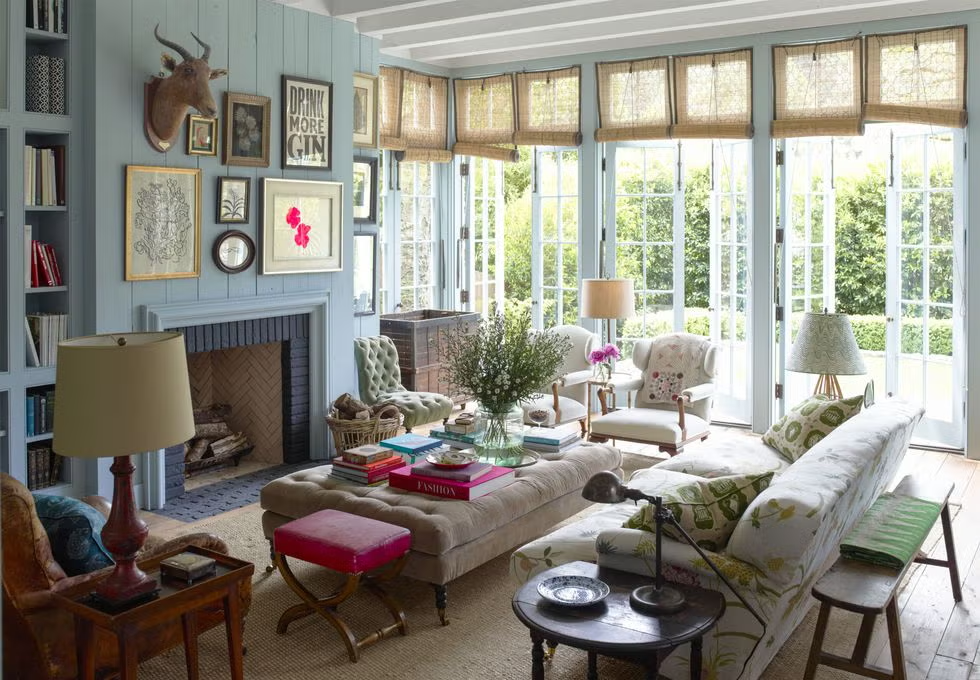
Eclectic design resonates with those who view their home as a personal canvas, one that is layered, expressive, and ever-evolving. It’s a style for collectors, creatives, and anyone who values individuality over uniformity. Whether mixing vintage with modern or global with local, eclectic interiors thrive on confidence, creativity, and a sense of story.
Classic and Luxurious
7. Traditional

Traditional interior design is characterised by timeless elegance, meticulous craftsmanship, and a profound appreciation for classic details. Rooted in 18th–19th century European décor, particularly English, French, and Neoclassical aesthetics, this style brings a sense of order, symmetry, and refinement to any space.
In Malaysia and other multicultural regions, Traditional interiors are often blended with local influences, creating a culturally rich, regionally grounded take on classic formality. The result? Warm, sophisticated spaces that feel refined yet inviting.
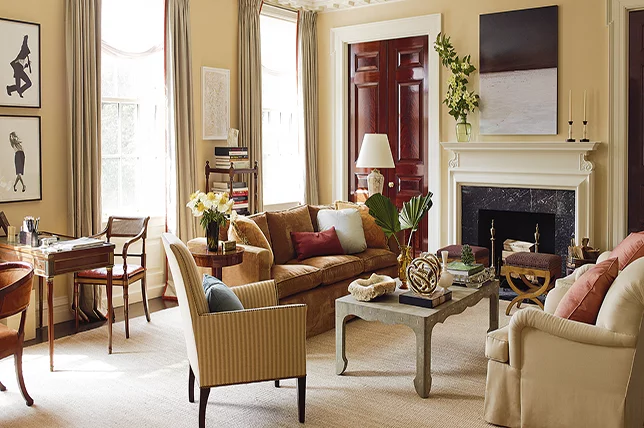
With rich textures, historical silhouettes, and meticulous symmetry, Traditional interiors feel layered, balanced, and enduring, like they’ve always belonged.
Elements | Description |
Palette | Warm neutrals, such as beige, ivory, and soft gold, form the base. Jewel tones (emerald, burgundy, navy) and earthy accents (terracotta, olive, mahogany) bring richness and depth. |
Materials | Dark woods (walnut, mahogany), velvet, silk, leather, and jacquard fabrics. Antique brass, marble, and patterned rugs add texture and formality. |
Texture and Shape | Ornate furniture with curves and carvings. Architectural detailing like mouldings, wainscoting, and trims. Layered window treatments and plush upholstery create softness. |
Lighting | Classic fixtures with antique finishes — chandeliers, sconces, and table lamps with fabric shades add warmth and elegance. |
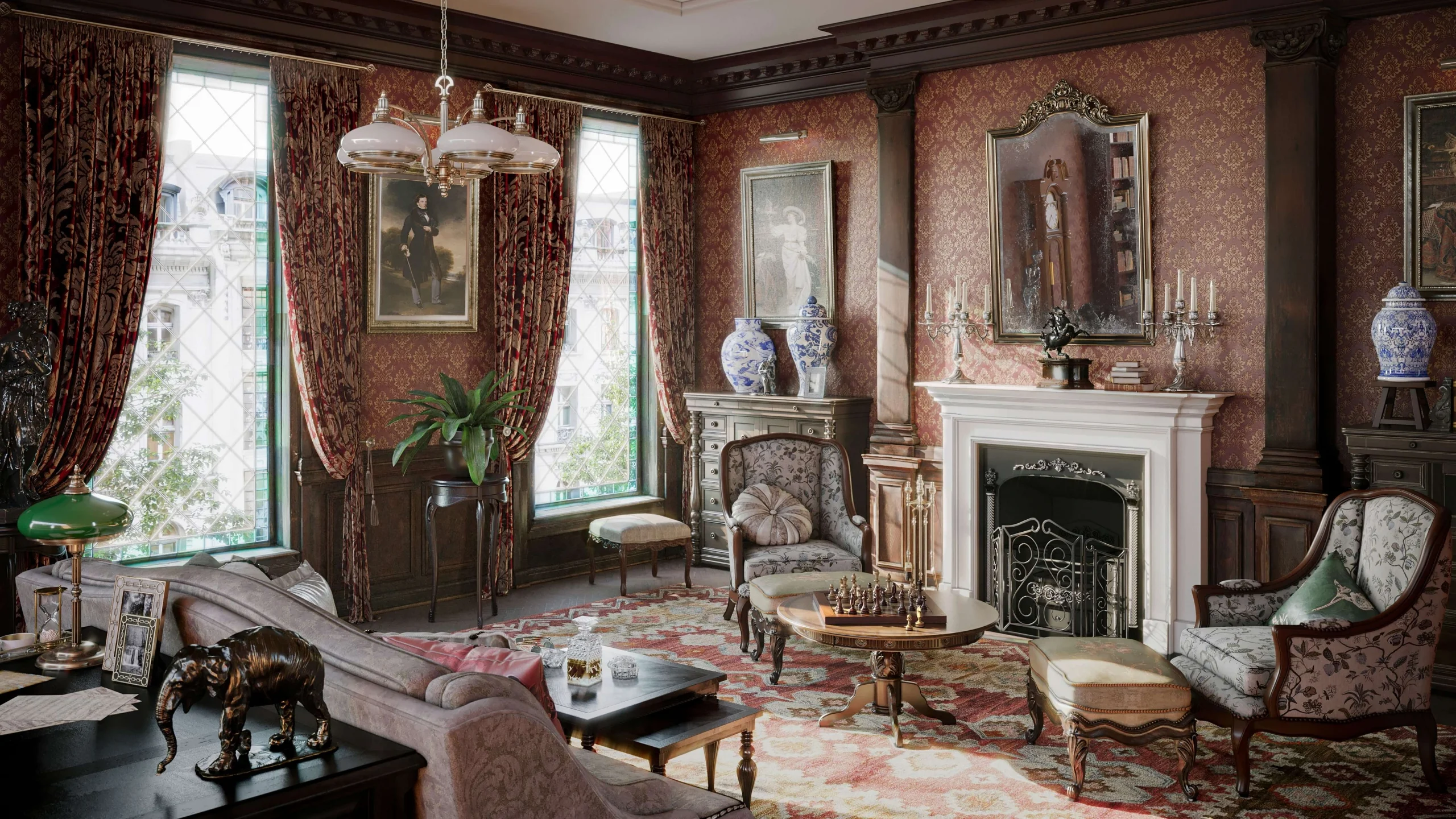
Traditional design resonates with those who value timeless beauty, heritage craftsmanship, and a sense of lasting elegance. It’s a style rooted in order and refinement, perfect for spaces that aim to feel established, graceful, and inviting.
Traditional Interior Design by Studio Pandan
Studio Pandan’s take on Traditional interiors showcases how modern living can honour cultural identity. The space blends the charm of Malaysian Modern Traditional design with coastal relaxation.
A Living Room with Local Soul
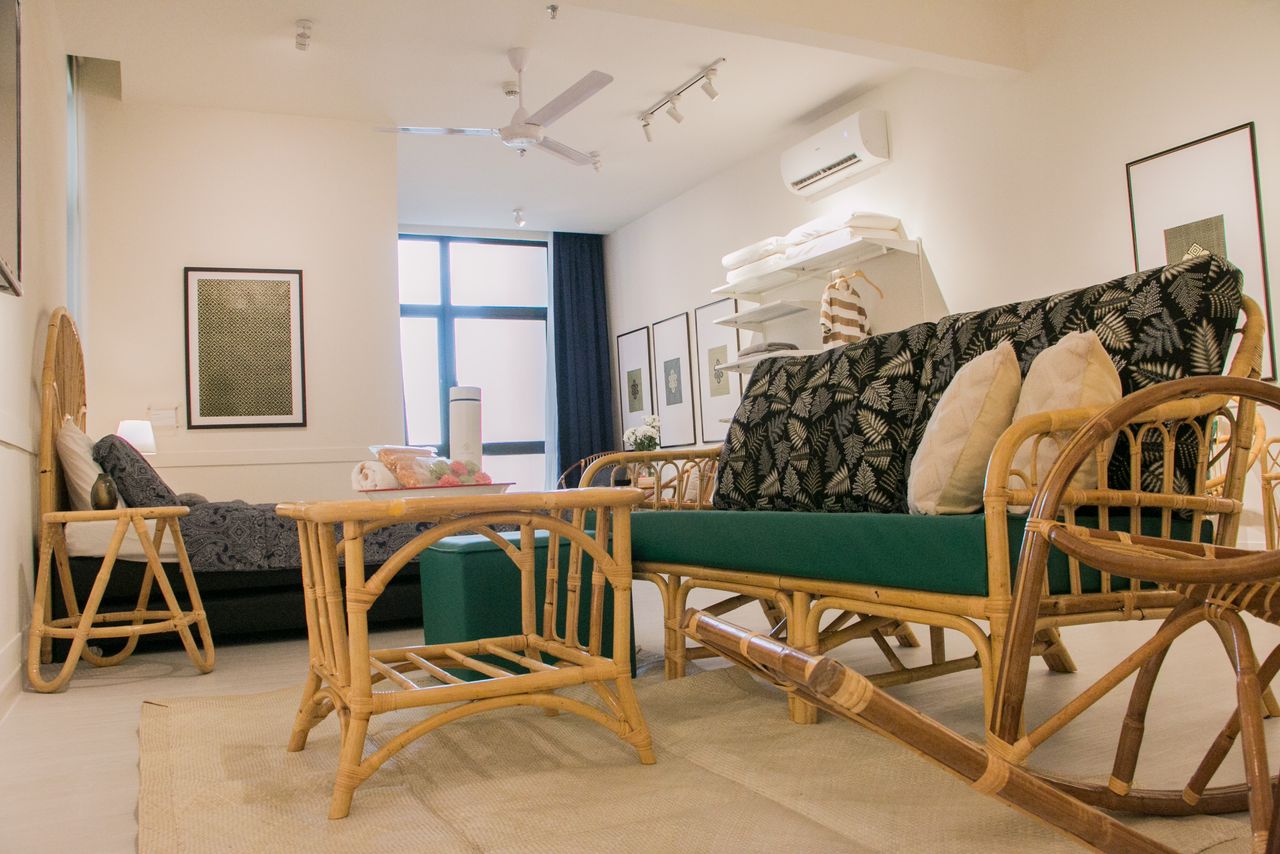
Natural rattan furniture takes centre stage, crafted in Sabah and arranged with intention. Handwoven art and batik-inspired patterns frame the room, offering guests a sense of place the moment they arrive.
A thoughtful mix of contemporary lines and traditional textures makes the space feel grounded, inviting, and unmistakably Malaysian, ideal for Muji design living room with local flair.
Craft, Community and Comfort
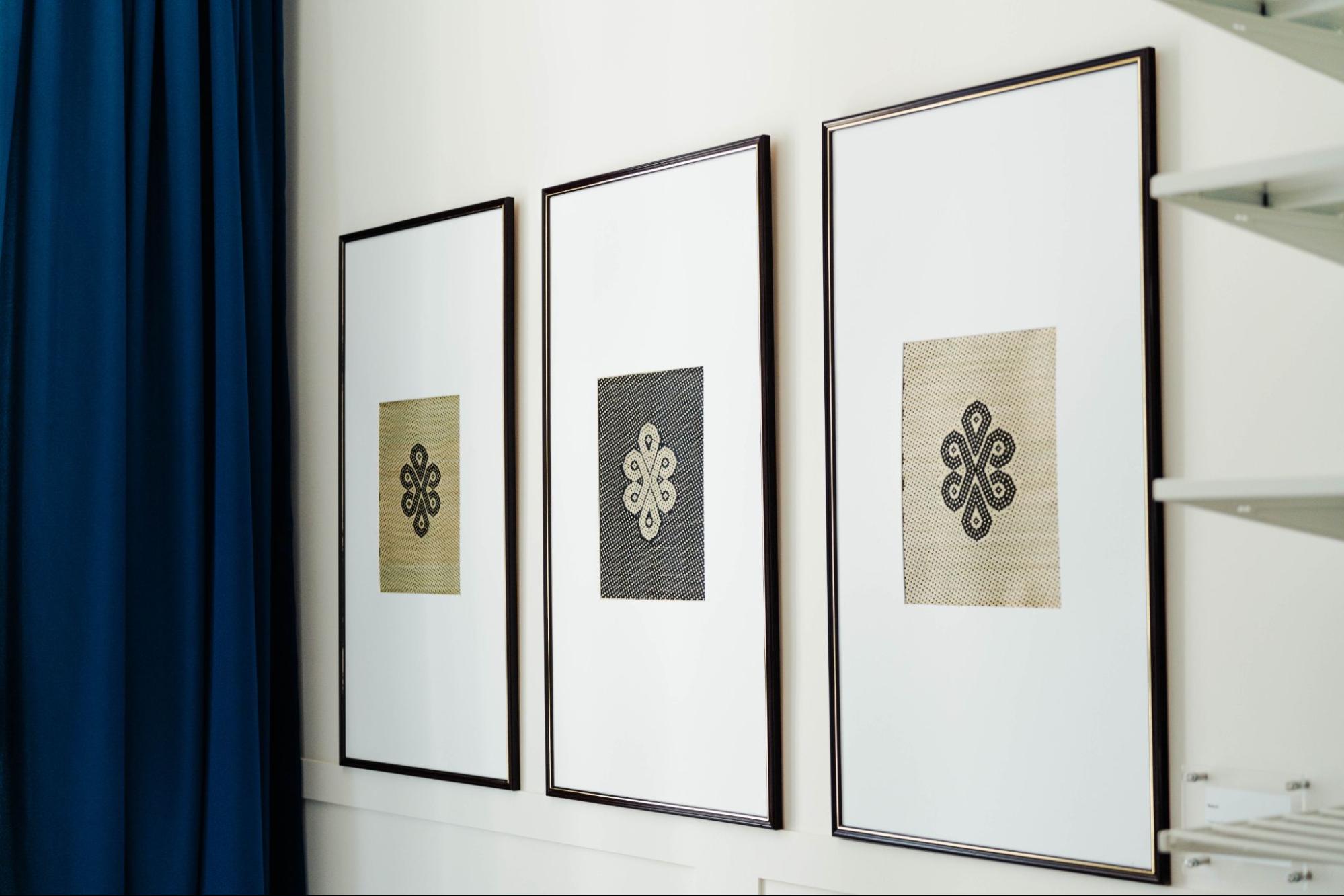
Much more than just styling, this renovation celebrates craft and collaboration. The furniture was custom-built using Sabah-sourced rattan, in partnership with local artisans and the Orang Asli community.
Woven artwork by the Kadazan Minokok tribe adds layers of meaning and visual interest, telling stories through texture and form. Paired with locally made décor and cultural accents, the unit offers guests a uniquely Malaysian experience in every detail.
A Cosy Corner with Cultural Warmth
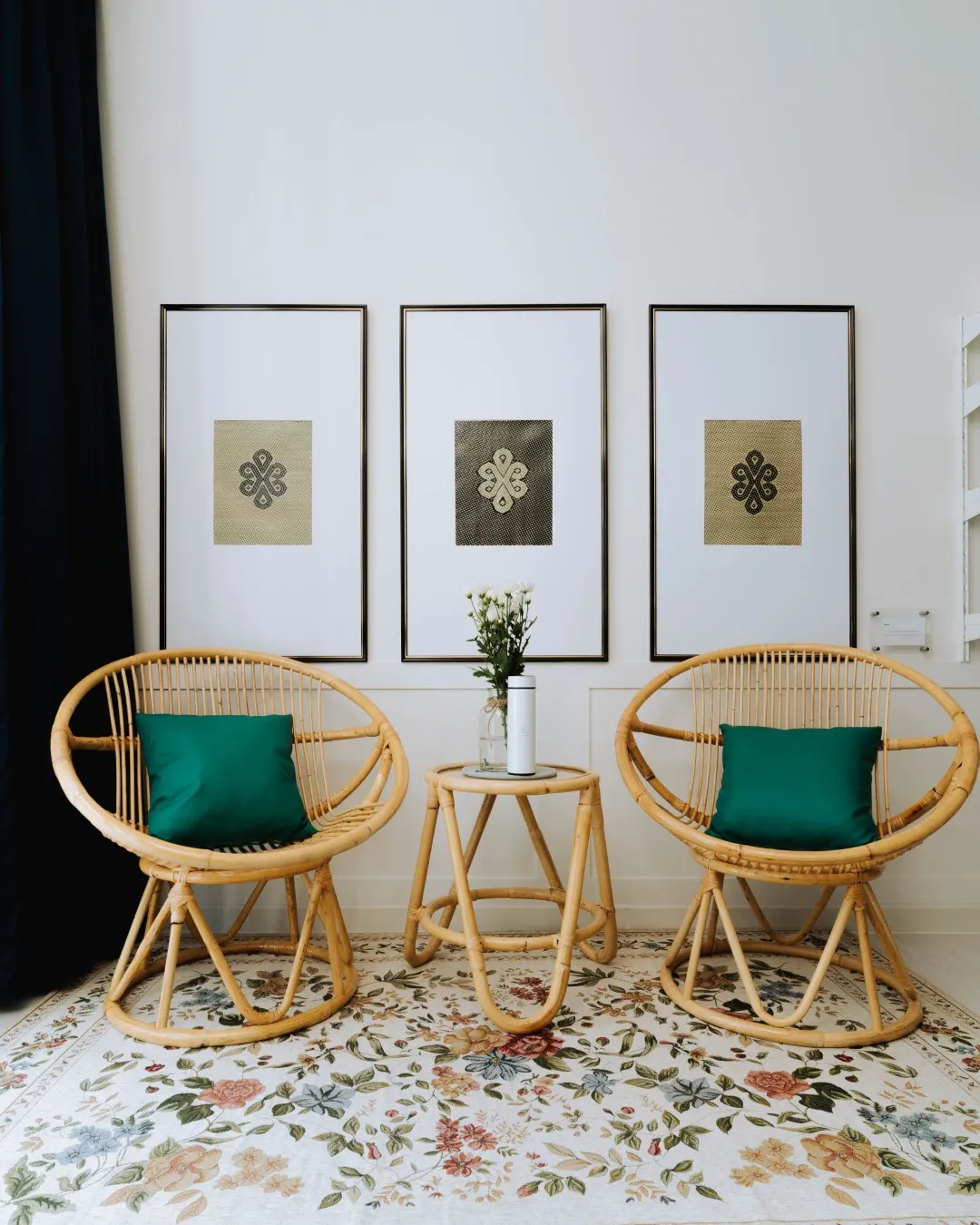
This intimate seating nook showcases thoughtful Airbnb styling, layering handcrafted rattan furniture, bold green accents, and traditional woven art.
Set against crisp white walls and a soft, floral rug, it offers guests a tranquil space to unwind, sip tea, or simply take in the view. Proof that meaningful design can thrive even in the smallest corners.
Love this look?
Explore more traditional-inspired homes and thoughtful reinterpretations in our full project gallery.
8. Art Deco
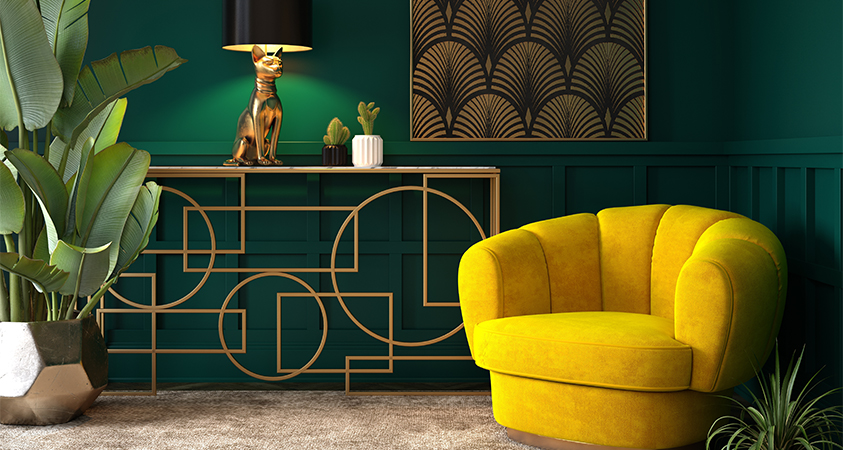
Art Deco interior design is bold, glamorous, and unapologetically luxurious. Originating in the 1920s and 1930s, it’s defined by geometric forms, rich materials, and a deep appreciation for symmetry and shine.
With high contrast, stylised motifs, and sculptural silhouettes, Art Deco evokes vintage elegance with a modern edge. From curved furniture and statement lighting to glossy finishes and metallic accents, it celebrates drama, executed with precision and polish.
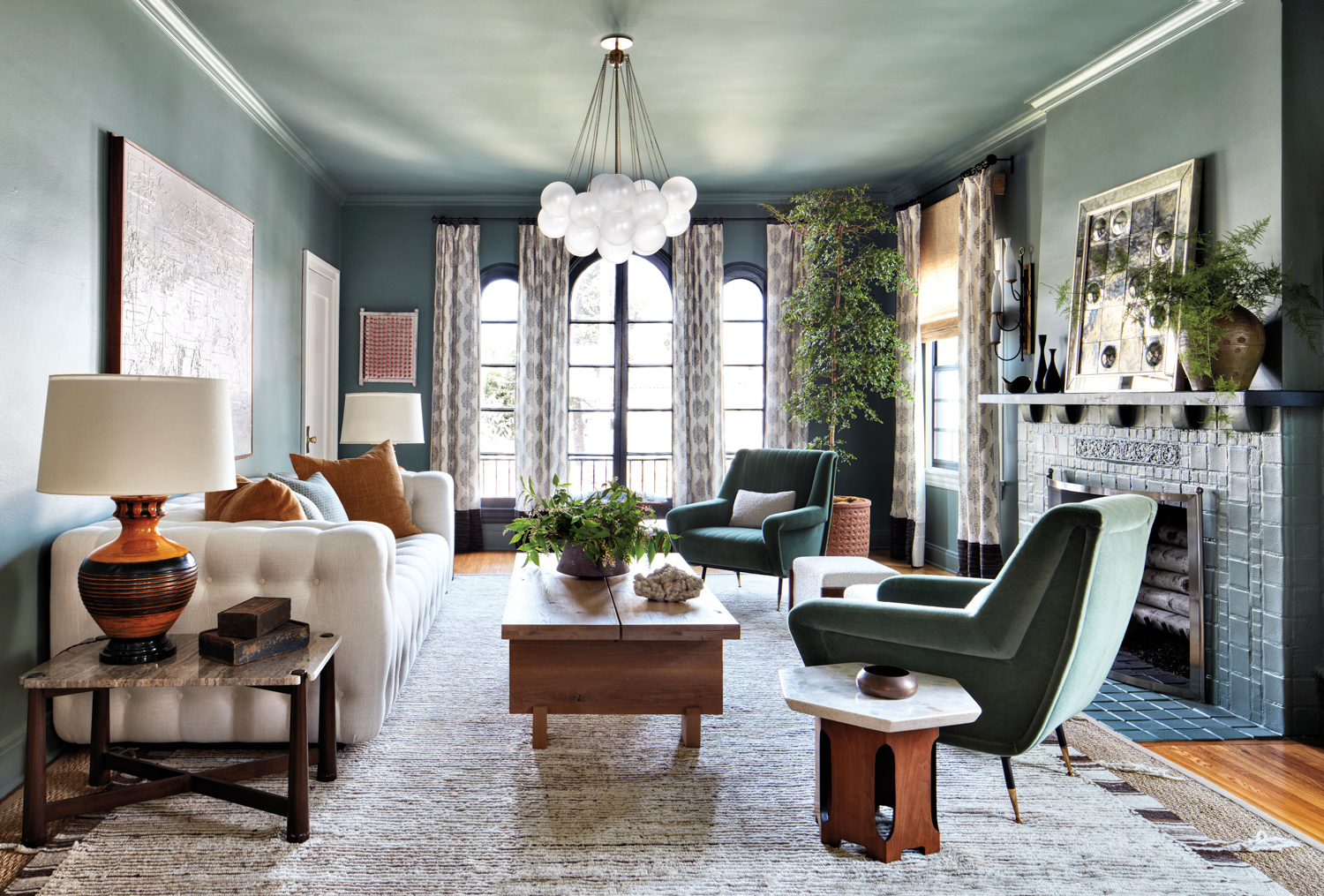
Art Deco interiors are confident and curated. They pair glossy finishes and strong shapes with plush textures and statement lighting. The result is a space that feels composed, charismatic, and unapologetically luxurious.
Elements | Description |
Palette | High-contrast hues like black, white, cream, and navy form the base. Accents in gold, brass, emerald, or deep burgundy enhance the drama. |
Materials | Lacquered wood, marble, velvet, chrome, and mirrored finishes. Glossy tiles and exotic woods (zebrawood, ebony) add richness. |
Texture and Shape | Geometric patterns (chevrons, zigzags, sunbursts), curved furniture silhouettes, and symmetrical arrangements define the aesthetic. Upholstered furniture often features piping, tufting, or fringe. |
Lighting | Decorative chandeliers, stepped sconces, and polished metal lamps. Frosted glass and patterned shades evoke vintage glamour. |
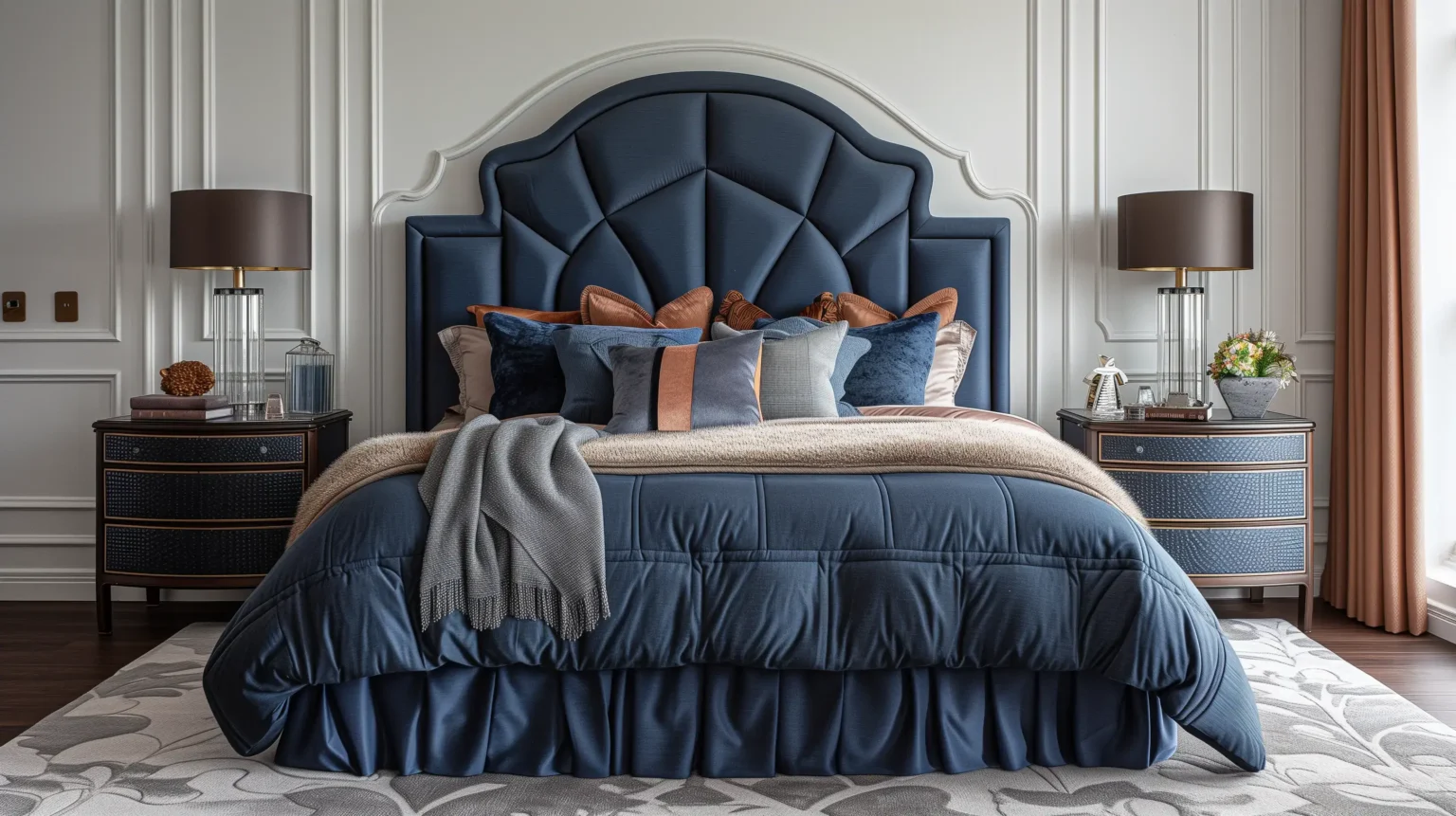
Art Deco resonates with those who appreciate bold aesthetics, vintage glamour, and luxurious finishes. It’s a style for people who want their space to make a statement — sophisticated, cinematic, and full of character.
9. Hollywood Regency

Like the behind-the-scenes magic of movie sets and the timeless glamour of old Hollywood stars, Hollywood Regency is all about drama, luxury, and bold personality. Born in the golden age of cinema, this style blends opulence with polish, transforming everyday spaces into stylish showpieces.
It’s not about excess — it’s about impact, with a few curated pieces that bring sparkle, sophistication, and cinematic flair.
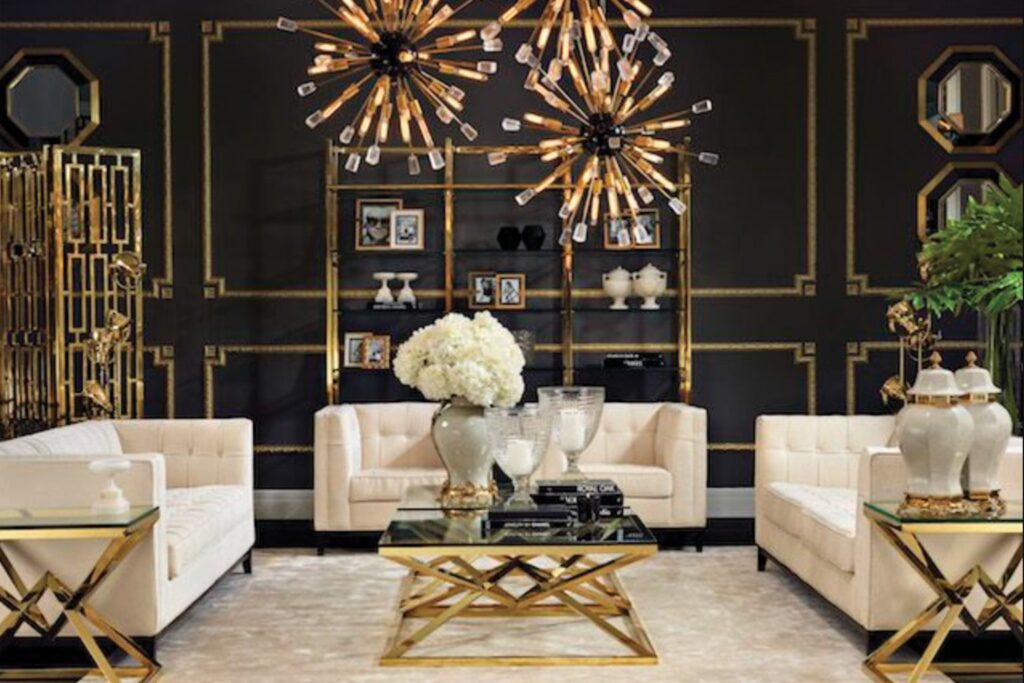
Hollywood Regency interiors are confident and charismatic. Every detail is meant to catch the eye, from glossy finishes to statement lighting. It’s a celebration of individuality, charm, and a little bit of cinematic elegance.
Elements | Description |
Palette | Bold contrasts, such as black and white, paired with jewel tones (emerald, sapphire, ruby) or soft pastels. Metallics (gold, chrome, brass) add glamour. |
Materials | Lacquer, velvet, glass, marble, and polished metals. Surfaces are shiny, reflective, or luxe to the touch. |
Texture and Shape | Sculptural furniture with curves and crisp lines. Tufted upholstery, glossy cabinetry, and layered accessories like mirrors, cushions, and trims. |
Lighting | Statement chandeliers, glossy lamps, and mirrored or metallic fixtures. Lighting is both functional and decorative, like a set piece. |
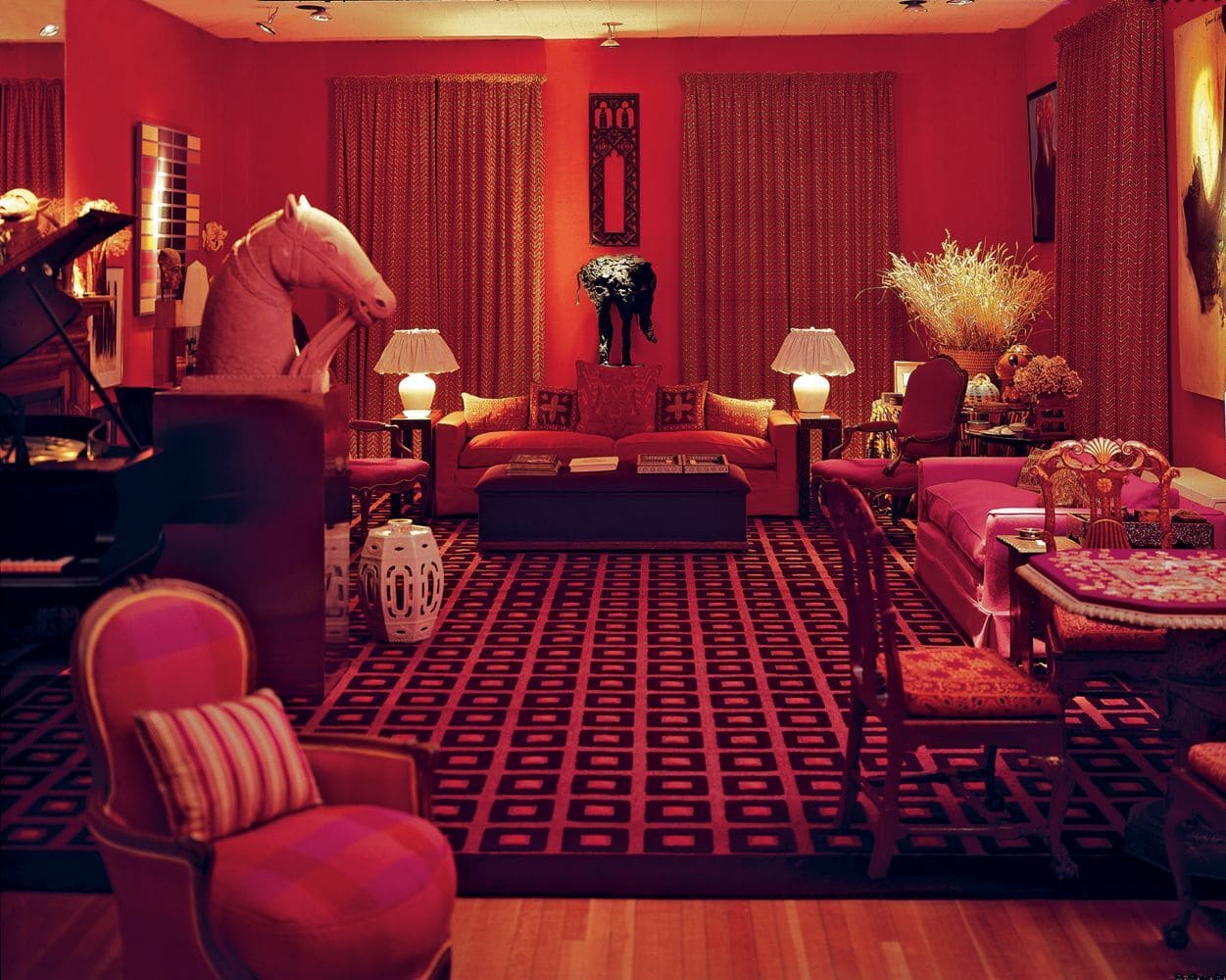
Hollywood Regency resonates with those who love bold style, vintage charm, and a flair for drama. It’s perfect for expressive personalities, glam-loving design lovers, and anyone who believes their home should make a statement.
10. Mediterranean
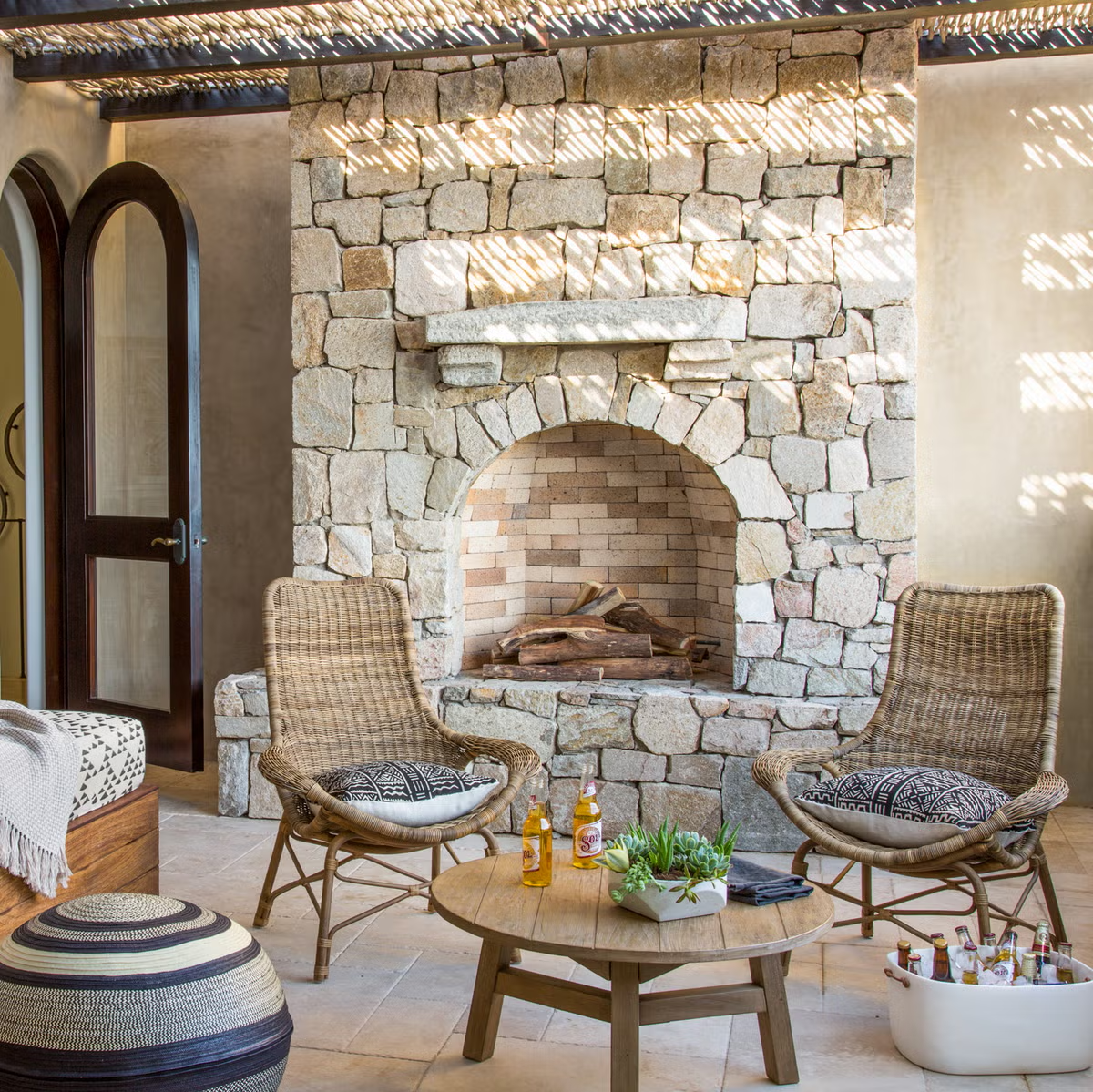
Mediterranean interior design brings the relaxed elegance of southern Europe into your home. Inspired by the coastal charm of countries like Spain, Italy, and Greece, this style blends rustic textures, sun-soaked colours, and breezy openness.
It’s warm, earthy, and inviting, perfect for anyone who dreams of slow afternoons, olive trees, and the sea breeze.
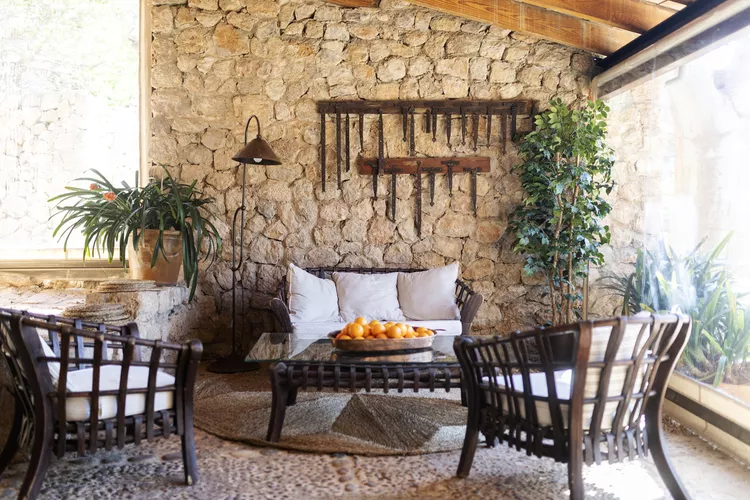
Mediterranean interiors feel sun-kissed and soulful. Spaces are open and airy, grounded by natural textures and elevated by soft curves and heritage craftsmanship. It’s casual but refined, a lived-in elegance that doesn’t try too hard.
Elements | Description |
Palette | Warm neutrals like sand, ivory, and taupe, layered with sun-baked tones: terracotta, ochre, sage green, and sea blues. |
Materials | Natural, tactile materials like stone, ceramic, terracotta, rattan, linen, and aged wood. Finishes are matte, organic, and timeless. |
Texture and Shape | Arched shapes, exposed beams, plaster walls, and carved woodwork. Handcrafted décor and artisanal details bring depth and authenticity. |
Lighting | Soft, diffused lighting from wrought iron pendants, wall sconces, and lantern-style fixtures. Candlelight adds extra warmth in the evenings. |
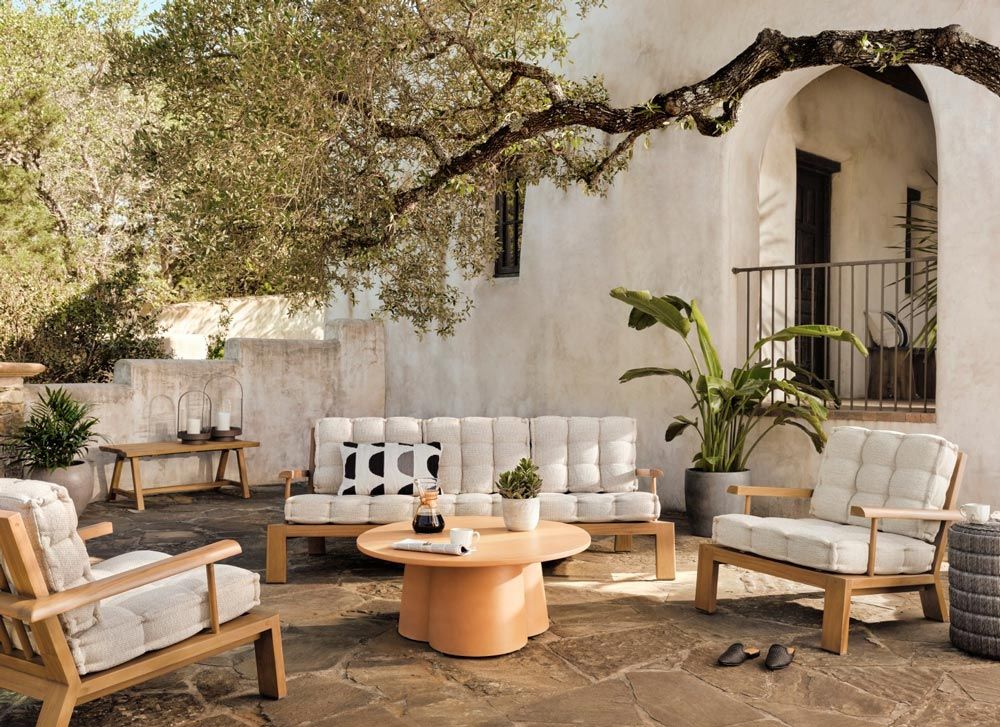
Mediterranean design resonates with those who value slow living, natural beauty, and cultural depth. It’s ideal for homeowners who love travel-inspired spaces, appreciate artisanal touches, and want a home that feels soulful, grounded, and connected to nature.
Rustic and Natural
11. Farmhouse
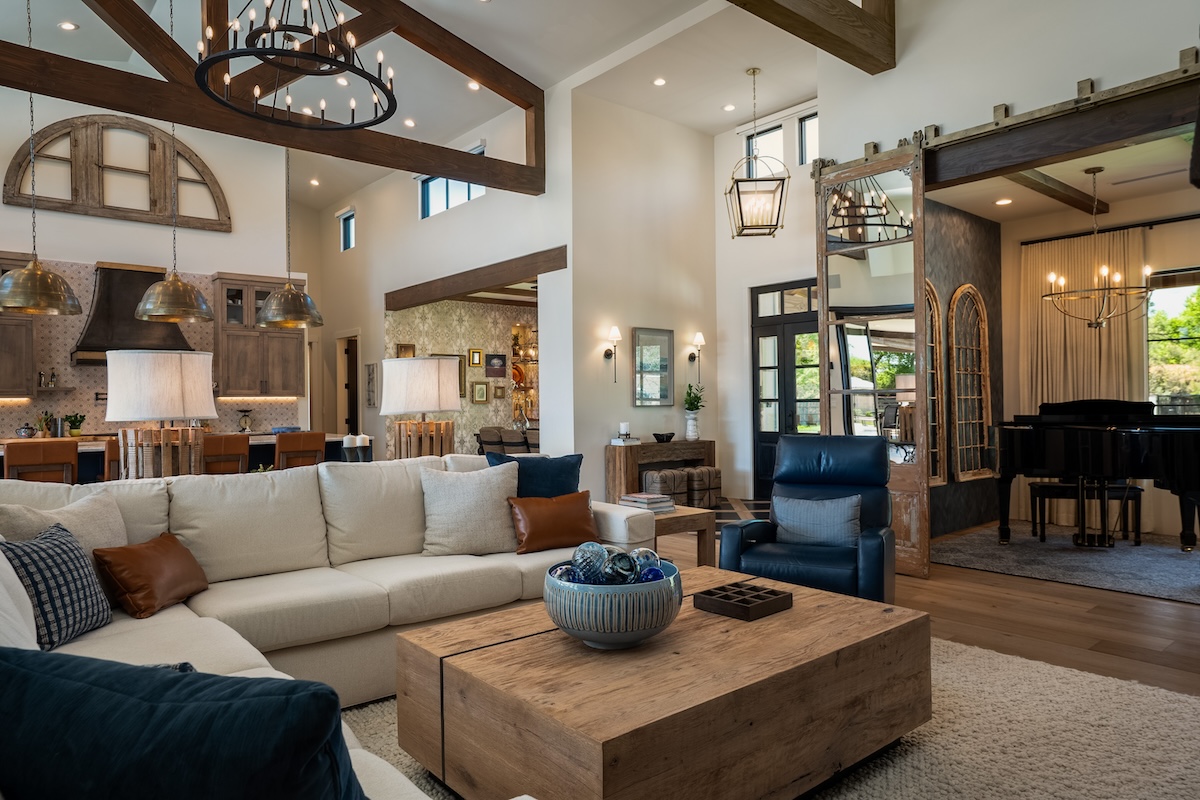
Farmhouse interior design feels like a warm hug from your home — cosy, welcoming, and full of heart. Rooted in rustic tradition but reimagined for modern living, it seamlessly blends natural textures and vintage touches, creating a look that feels both timeless and lived-in.
Modern farmhouse style combines the best of classic farmhouse elements with cleaner lines, lighter palettes, and simplified styling, making it equally at home in a country cottage as it does in a city apartment.
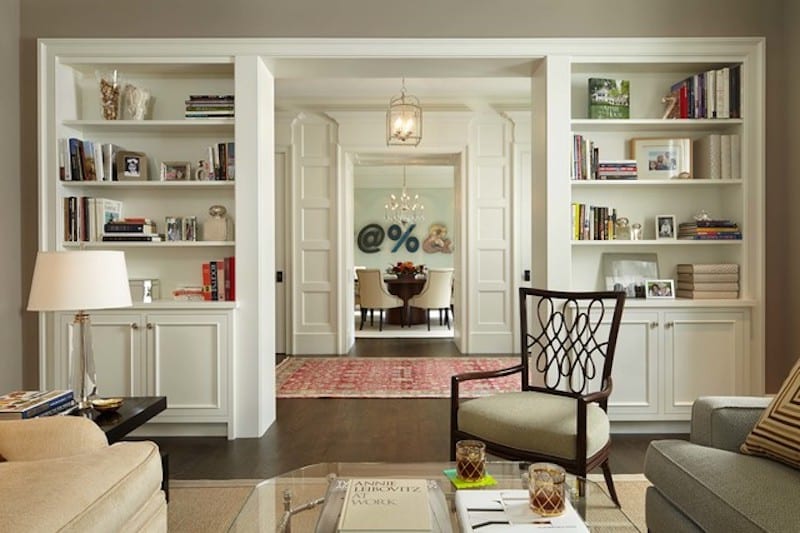
Farmhouse interiors are grounded in comfort. From shiplap walls to open shelving and cosy nooks, the focus is on warmth, character, and honest materials that tell a story.
Elements | Description |
Palette | Soft neutrals, such as cream, beige, and greige, paired with warm woods. Accents in black, navy, sage, or rust add contrast and depth. |
Materials | Reclaimed wood, wrought iron, linen, cotton, aged metals, and vintage-style ceramics. Surfaces are often matte or distressed |
Texture and Shape | Mix of raw and refined, such as chunky wood tables, classic slipcovered sofas, and vintage-inspired fixtures. Furnishings feel sturdy, yet inviting. |
Lighting | Lantern-style pendants, iron chandeliers, and warm-toned sconces create a cozy glow. Natural light is maximised wherever possible. |
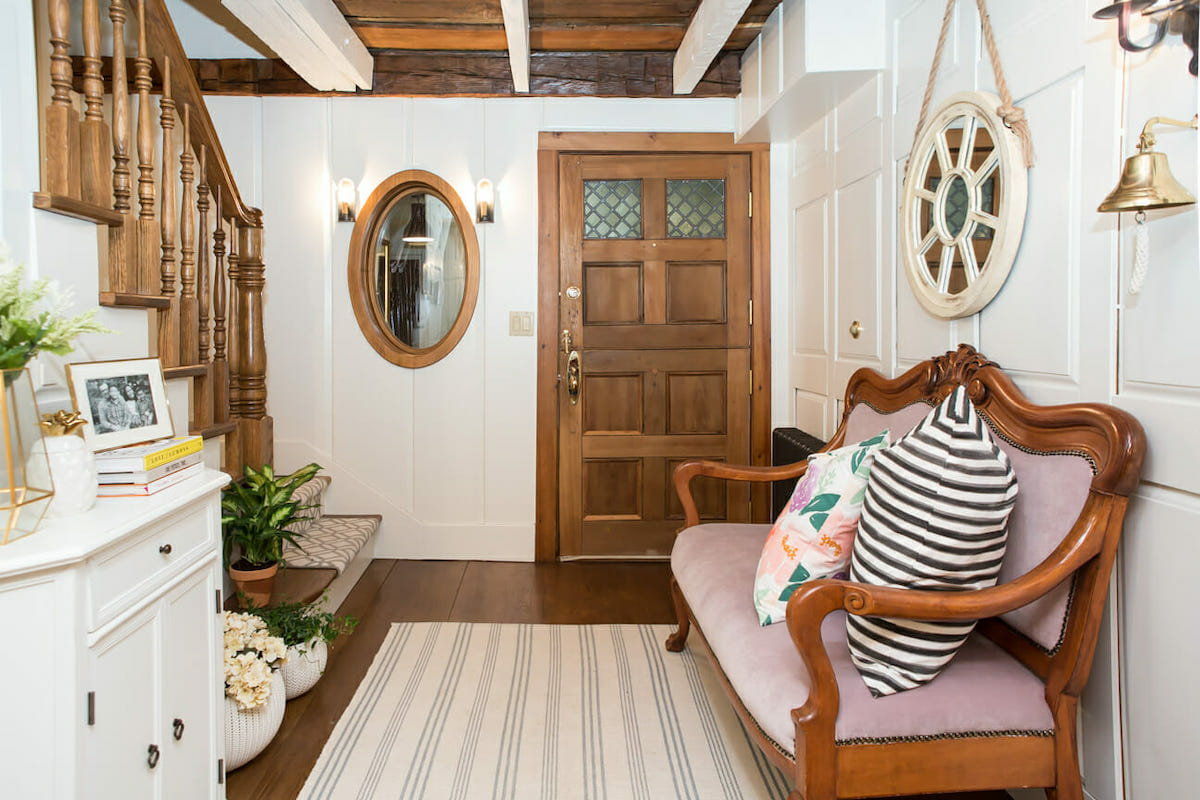
Farmhouse design resonates with those who love relaxed, meaningful spaces with soul. It’s perfect for anyone who values comfort, craftsmanship, and a connection to simpler living, whether you live in the countryside or just want your home to feel like a retreat.
12. Bohemian
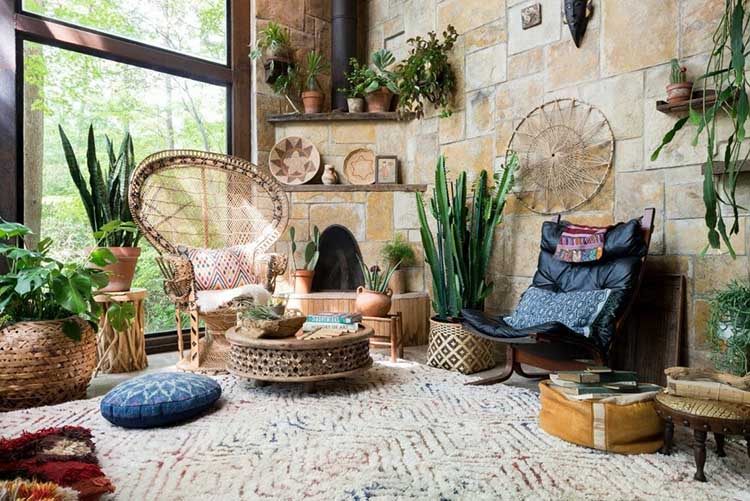
Seeking something distinct from the typical clean, modern aesthetic? How about Bohemian for a change? This design style is relaxed, expressive, and full of soul. Rooted in the free-spirited lifestyle of artists, travellers, and creatives, Boho is all about mixing and layering colours, textures, patterns, and stories.
Bohemian interiors don’t follow trends; they follow feeling. This style breaks all the conventional rules to create homes that feel personal, collected, and effortlessly lived-in.
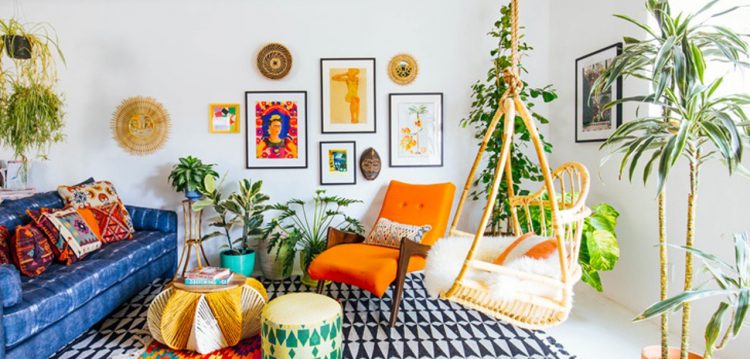
Bohemian interiors are warm, inviting, and layered with life. They celebrate imperfection, embrace creativity, and often feel as though they’ve evolved over time, with no two spaces ever quite the same.
Elements | Description |
Palette | Earthy tones, such as terracotta, ochre, and sand, create warmth, while jewel tones (emerald, ruby, and deep blue) and metallics add drama. Whites and neutrals often ground the palette. |
Materials | Natural and handcrafted: rattan, jute, wood, leather, macramé, linen, and clay. Mixed with vintage pieces and layered textiles for a relaxed, textured look. |
Texture and Shape | Patterned rugs, throw pillows, woven baskets, and eclectic furniture styles — curves, carvings, and vintage silhouettes are common. Layering is key |
Lighting | Soft, ambient lighting, think lanterns, string lights, woven pendants, and lamps with warm-toned bulbs or fabric shades for a cosy, dreamy atmosphere. |
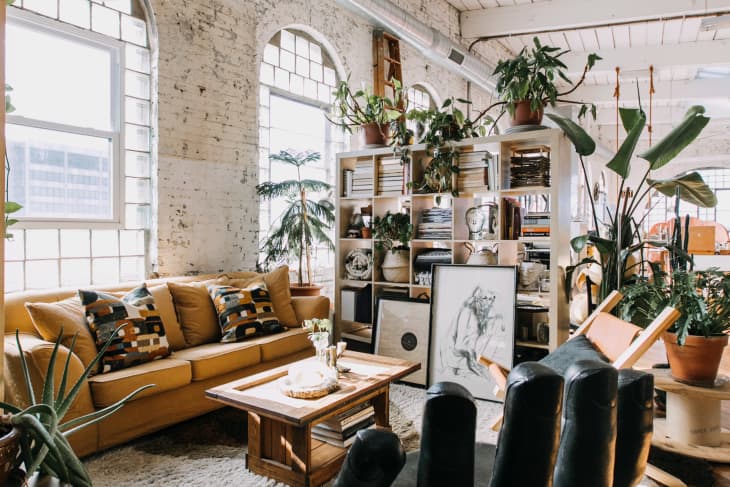
Bohemian style resonates with those who value self-expression, global influences, and a space that feels collected, not curated. It’s ideal for free spirits, creative souls, and anyone who wants their home to reflect who they are — layered, soulful, and a little bit wild.
Drawn to the peaceful charm of Muji interiors? Learn how to create a Muji-inspired living room with our design guide.
13. Coastal

Coastal interior design brings the breezy calm of seaside living into your home, no matter how far you are from the ocean! Inspired by the colours, textures, and lightness of coastal environments, this style is relaxed, airy, and effortlessly fresh.
It’s not about seashell décor or nautical stripes (though those can play a part); it’s about capturing the essence of coastal life, such as openness, comfort, and a connection to nature.
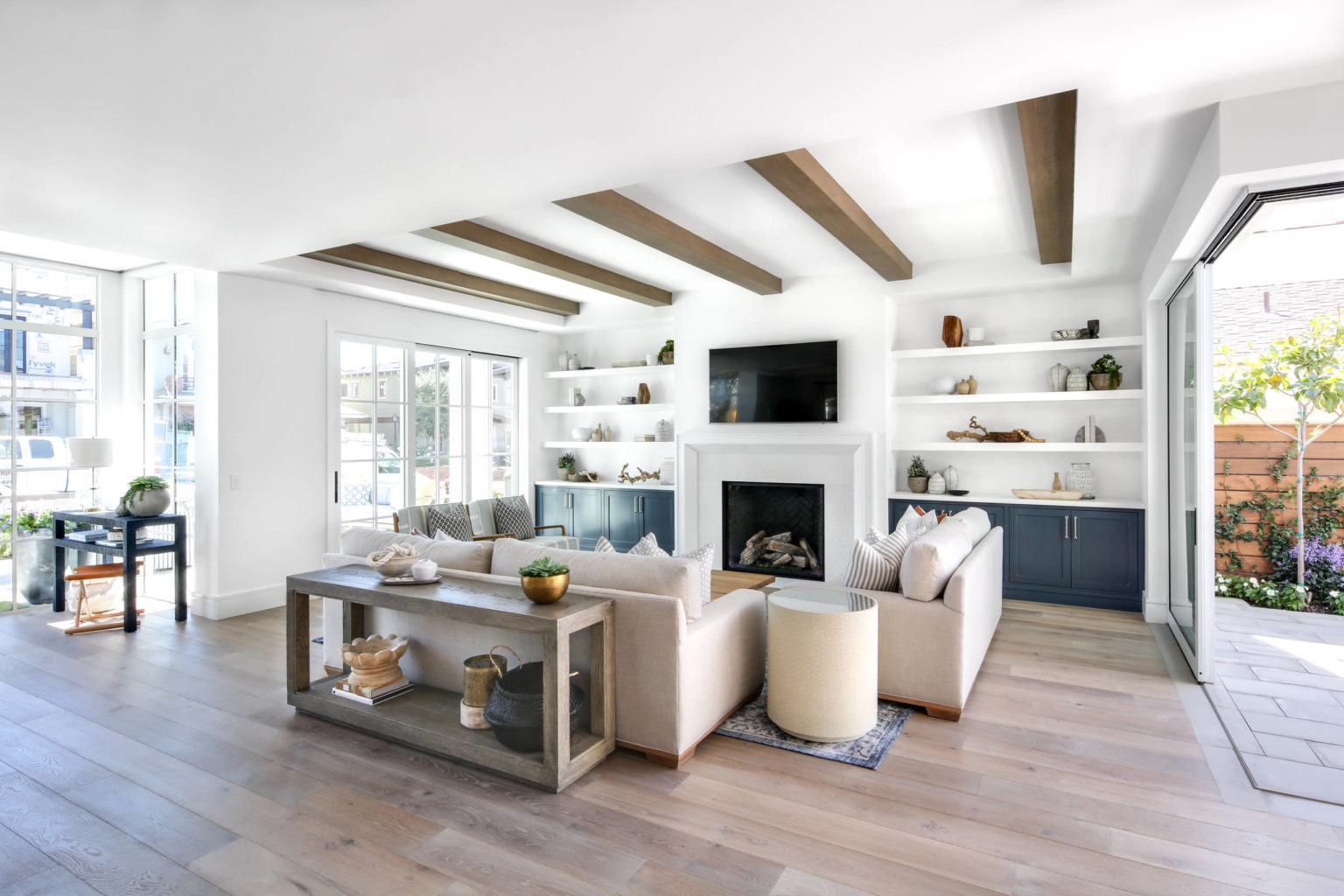
Coastal interiors are all about softness and serenity. With a palette inspired by sand, sea, and sky, these spaces feel sun-drenched and breathable, ideal for unwinding or entertaining with ease.
Elements | Description |
Palette | Soft whites, warm neutrals, sandy beige, seafoam, sky blue, and driftwood grey. Pops of navy or aqua can add a crisp accent.. |
Materials | Natural textures like linen, cotton, rattan, wicker, reclaimed wood, and jute. Light finishes and bleached timbers reflect a coastal, sun-washed vibe. |
Texture and Shape | Slipcovered sofas, relaxed upholstery, open-weave rugs, and breezy curtains. Shapes are casual, comfortable, and unfussy. |
Lighting | Emphasis on natural light. Fixtures are often light-toned, woven, or glass-based, evoking sunshine and clarity. |
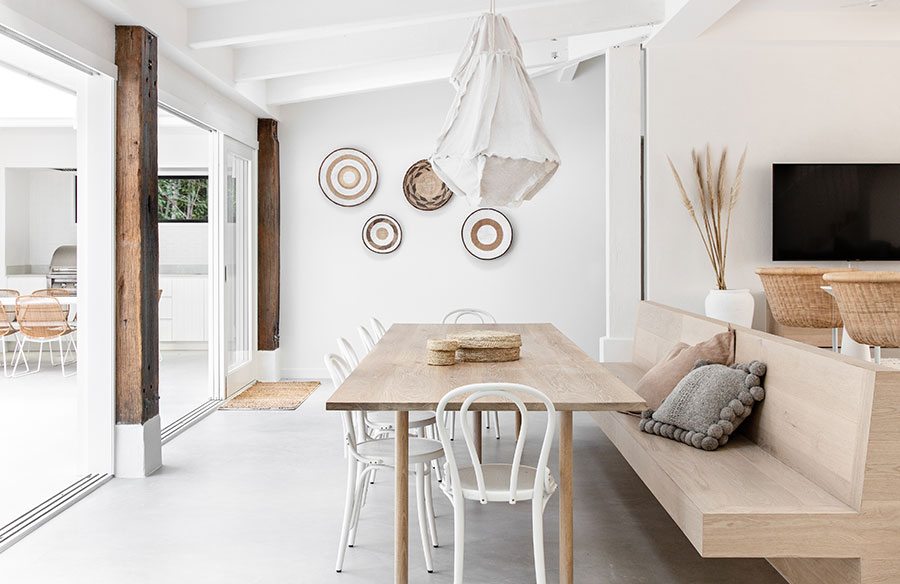
Coastal design resonates with those who crave a calm, inviting space with a sense of escape. It suits homeowners who love open air, soft textures, and the easy rhythm of beachside living, whether you’re by the sea or simply dreaming of it.
Minimal and Functional
14. Minimalist
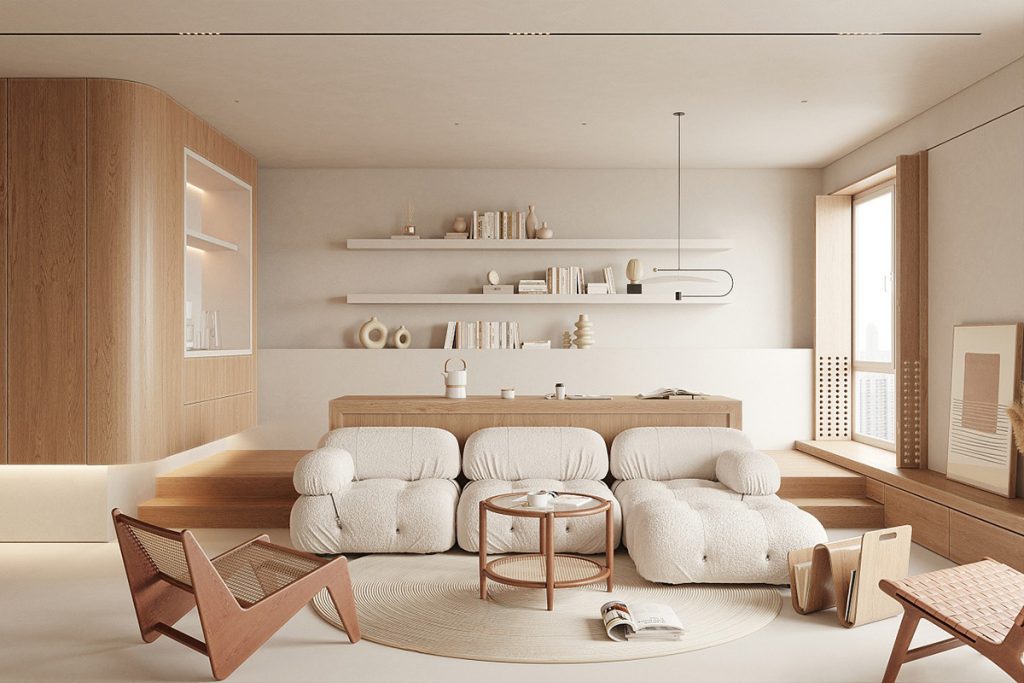
Minimalist interior design is the ultimate expression of “less is more”. Rooted in simplicity and intentionality, this style strips away the excess to highlight only what truly matters. It’s not about empty spaces — it’s about thoughtful ones.
Every item has a role. Every surface breathes. The result is a calm, uncluttered environment that promotes clarity, focus, and a sense of peace.
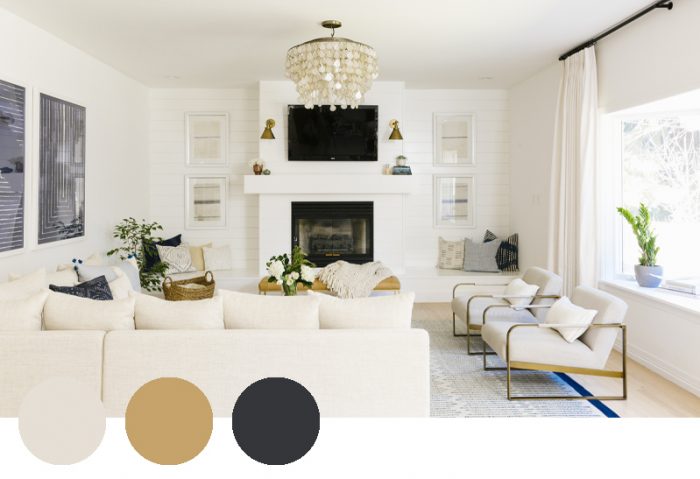
Minimalist interiors are characterised by lightness, openness, and meticulous editing. It’s a style that thrives on restraint, allowing space, form, and materials to shine quietly.
Elements | Description |
Palette | Primarily monochromatic: crisp white, soft grey, beige, black. Occasionally accented with muted tones like sage, stone, or oatmeal to add warmth without visual clutter. |
Materials | Natural and refined: light woods (birch, oak), smooth stone, glass, linen, and brushed metal. Finishes are seamless and matte, emphasising texture over colour. |
Texture and Shape | Clean lines and simple geometric forms. Negative space plays a significant role, with shapes that are soft-edged, balanced, and visually light. |
Lighting | Maximised natural light. Fixtures are minimal and architectural — think recessed lights, slimline pendants, and hidden sources that enhance the openness. |
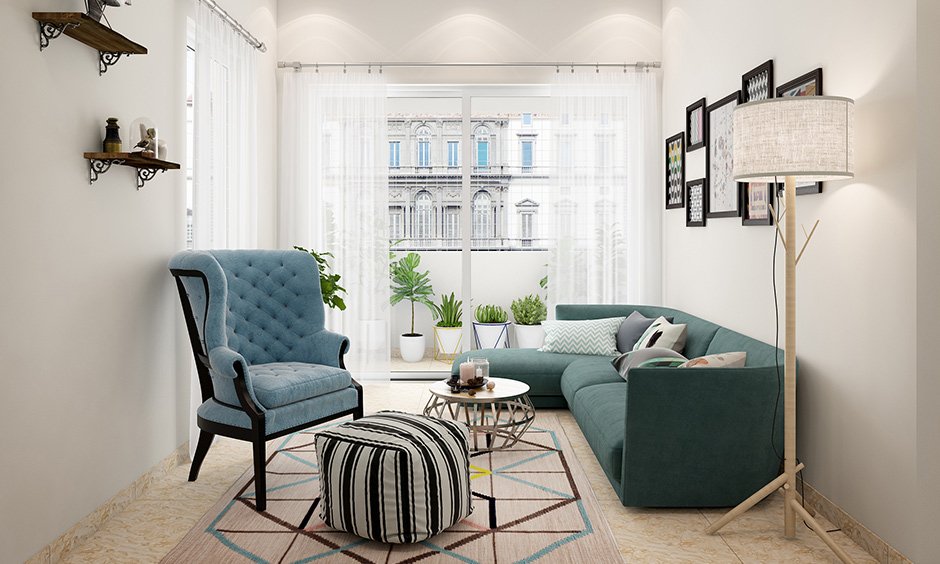
Minimalism resonates with those who value serenity, simplicity, and purposeful living. It appeals to homeowners seeking a peaceful, low-maintenance sanctuary and professionals drawn to clean, modern aesthetics.
Minimalist Interior Design by Studio Pandan
Studio Pandan’s minimalist interiors celebrate clarity, calm, and thoughtful restraint. These light-filled, balanced spaces demonstrate how intentional design, with clean lines, natural textures, and a muted palette, can transform simplicity into sophistication.
Minimalist Living Room
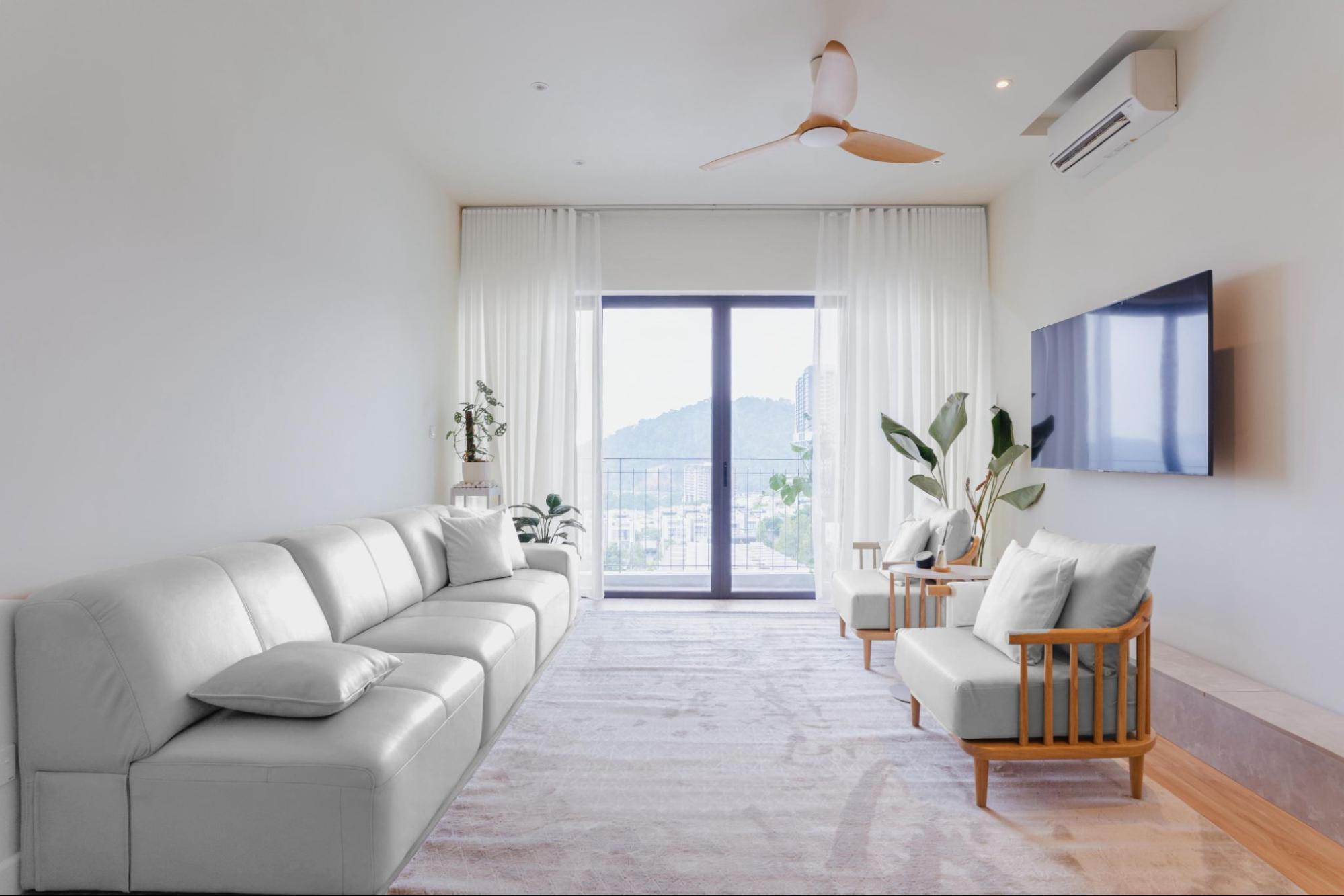
Soft white walls, a pale-toned area rug, and a seamless blend of natural light create a visually refreshing space in this living room. A low-profile leather sofa anchors the room, while wooden armchairs with light, cushioned seats introduce warmth and organic texture.
Full-length sheer curtains allow daylight to pour in while maintaining privacy and softness, embodying minimalist Muji interior design.
Minimalist Dining and Kitchen Area
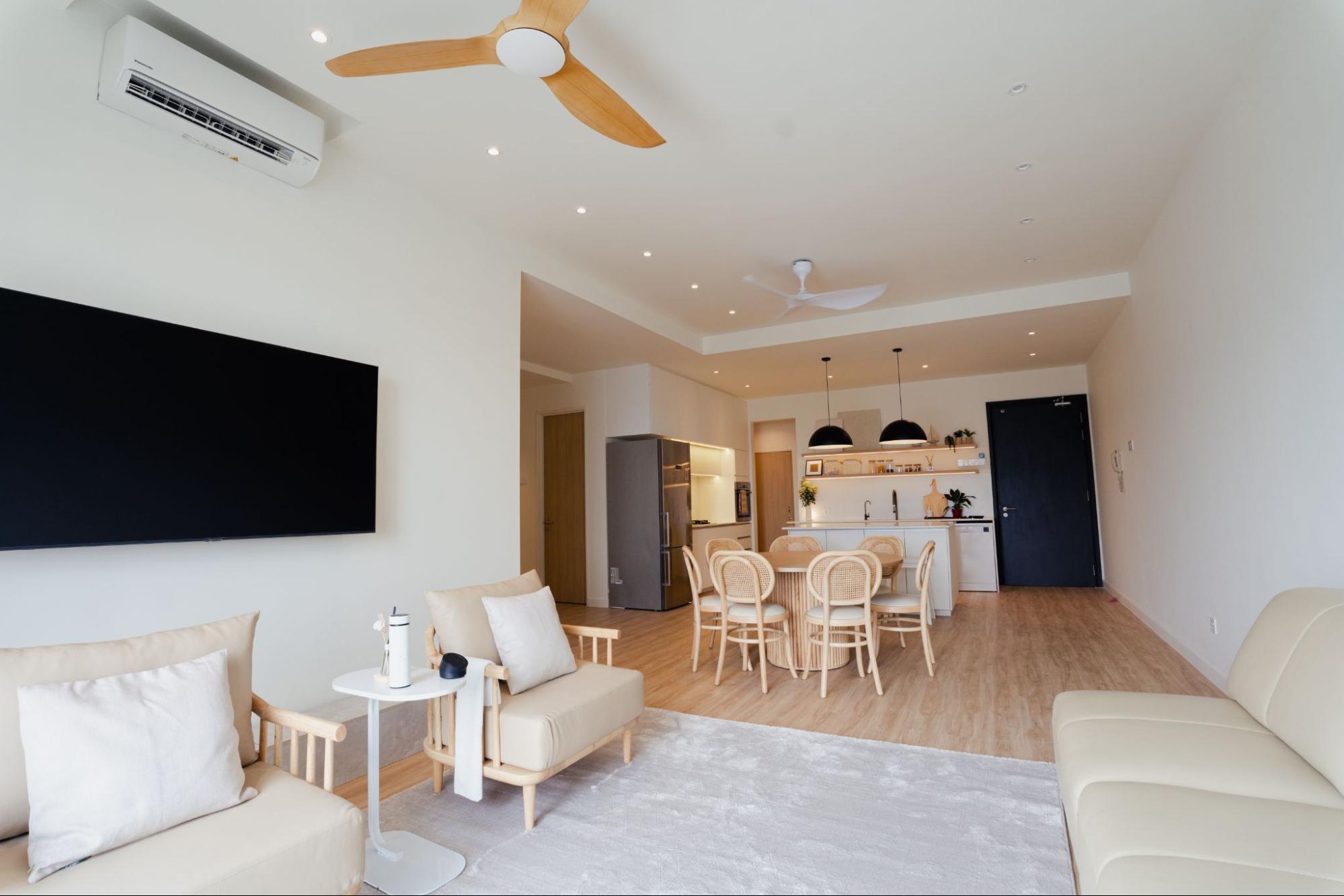
Function meets finesse in this soft-toned open-plan kitchen and dining space. Light-toned rattan dining chairs complement the wooden floors, while black pendant lights create a subtle contrast. Clean lines and neutral tones seamlessly unify the kitchen, dining, and living areas.
Kitchen Details That Work

Streamlined white cabinetry with handle-less fronts, open timber shelving, and matte black accents define the minimalist aesthetic, which is clean, modern, and highly functional. The subtle contrast between black fittings and natural wood tones adds warmth while keeping the look fresh and uncluttered.
Custom cabinetry and a lowered counter height offer ergonomic ease tailored to the homeowner’s needs. Underlit shelves bring a soft ambient glow, and the open shelving introduces a touch of curated personality without visual clutter.
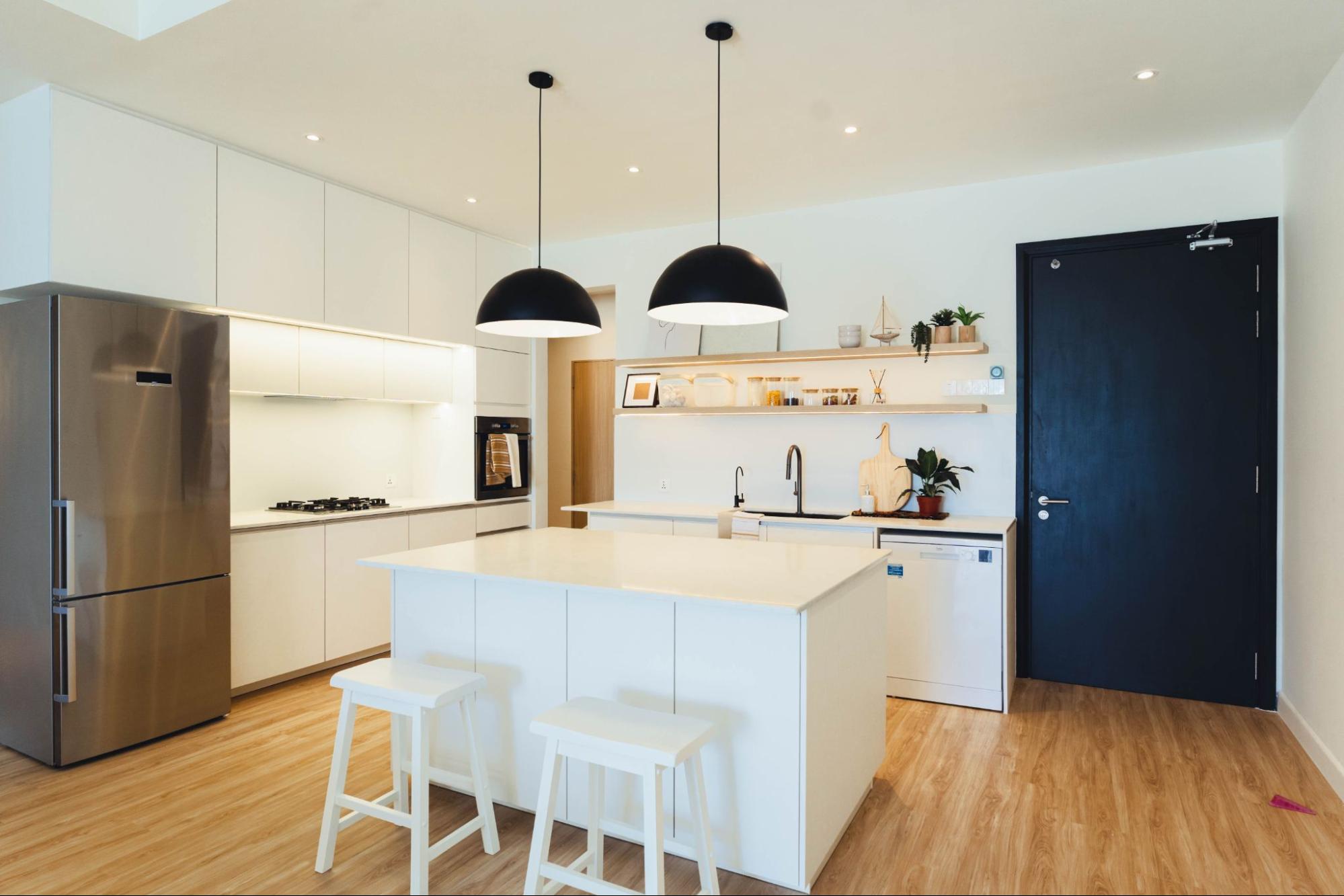
At the heart of the kitchen, the central island anchors the space, serving effortlessly as a prep zone, casual dining spot, and gathering hub in one seamless design.
Discover the Art of Minimalism
Love what you see? Dive deeper into Studio Pandan’s world of elevated minimalism, where clean lines meet calm living, and every detail is curated with purpose.
15. Scandinavian
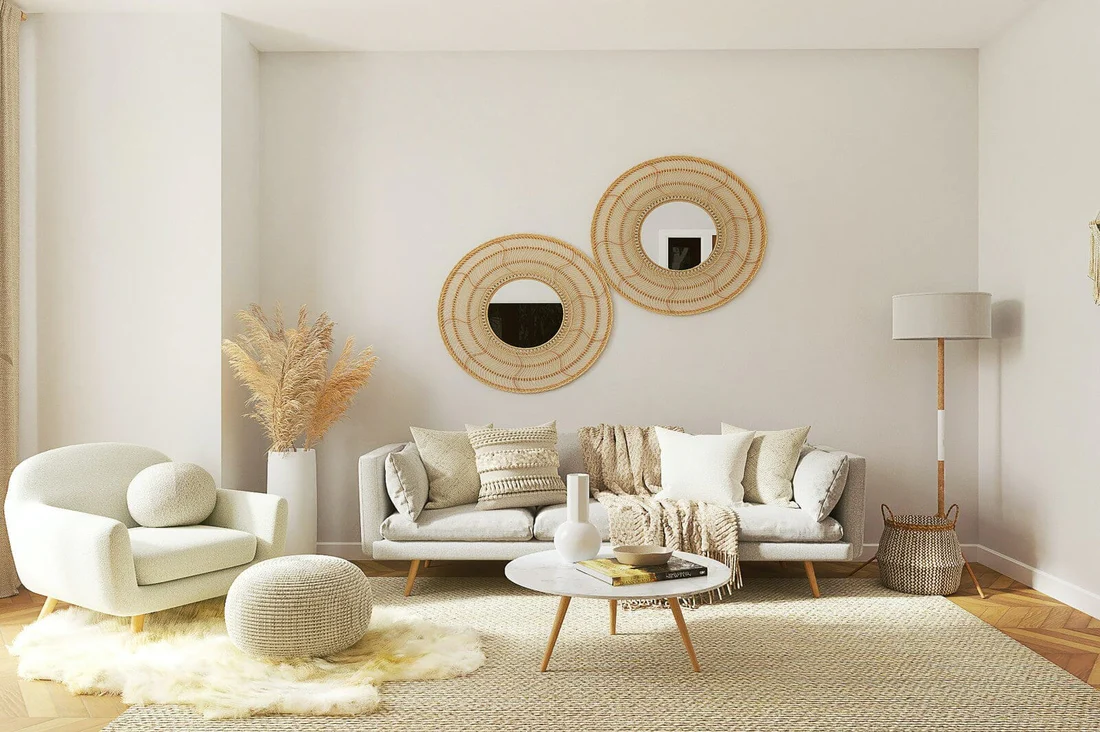
Scandinavian interior design is calm, cosy, and refreshingly simple. Originating from the Nordic countries, this style emphasises functional beauty, where every item serves a purpose, and every space feels light, open, and livable.
Known for its use of light colours, natural textures, and understated elegance, Scandinavian interiors make even the smallest homes feel bright and spacious.

At its core, Scandinavian design is all about simplicity done beautifully. It strips away the unnecessary, focusing on light, function, and natural warmth.
Elements | Description |
Palette | Light and airy — whites, soft greys, muted beige, and pale blues. Black accents add contrast, while pops of pastel or natural wood bring warmth. |
Materials | Natural and tactile: light woods (ash, pine), linen, wool, leather, and ceramics. The finish is matte and soft to the touch. |
Texture and Shape | Simple, clean-lined furniture with soft curves and tapered legs. Spaces use layering — think throws, cushions, and rugs — to create coziness (or “hygge,” the Danish word for comfort). |
Lighting | Natural light is maximised with sheer curtains and large windows. Fixtures are sleek and functional — metal pendants, wall sconces, or sculptural floor lamps keep things visually light. |
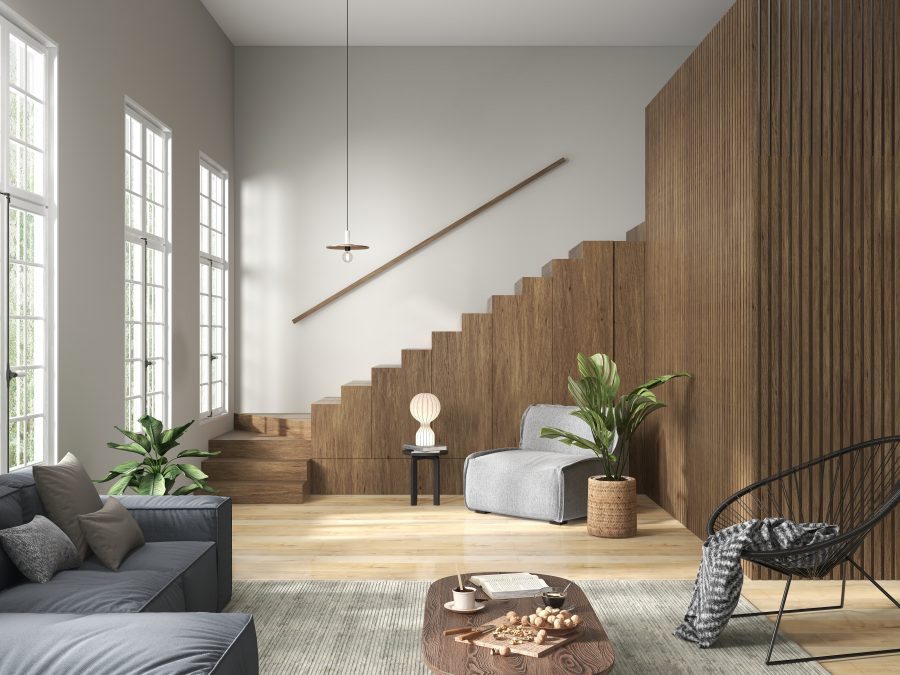
Scandinavian design resonates with homeowners who seek a calm, functional home with a distinct personality. It’s perfect for young professionals, new families, or anyone who wants simplicity with soul.
This style pairs well with Minimalist, Japandi, or even Boho elements, offering flexibility whether you love neutrals or want to add playful accents.
16. Japandi
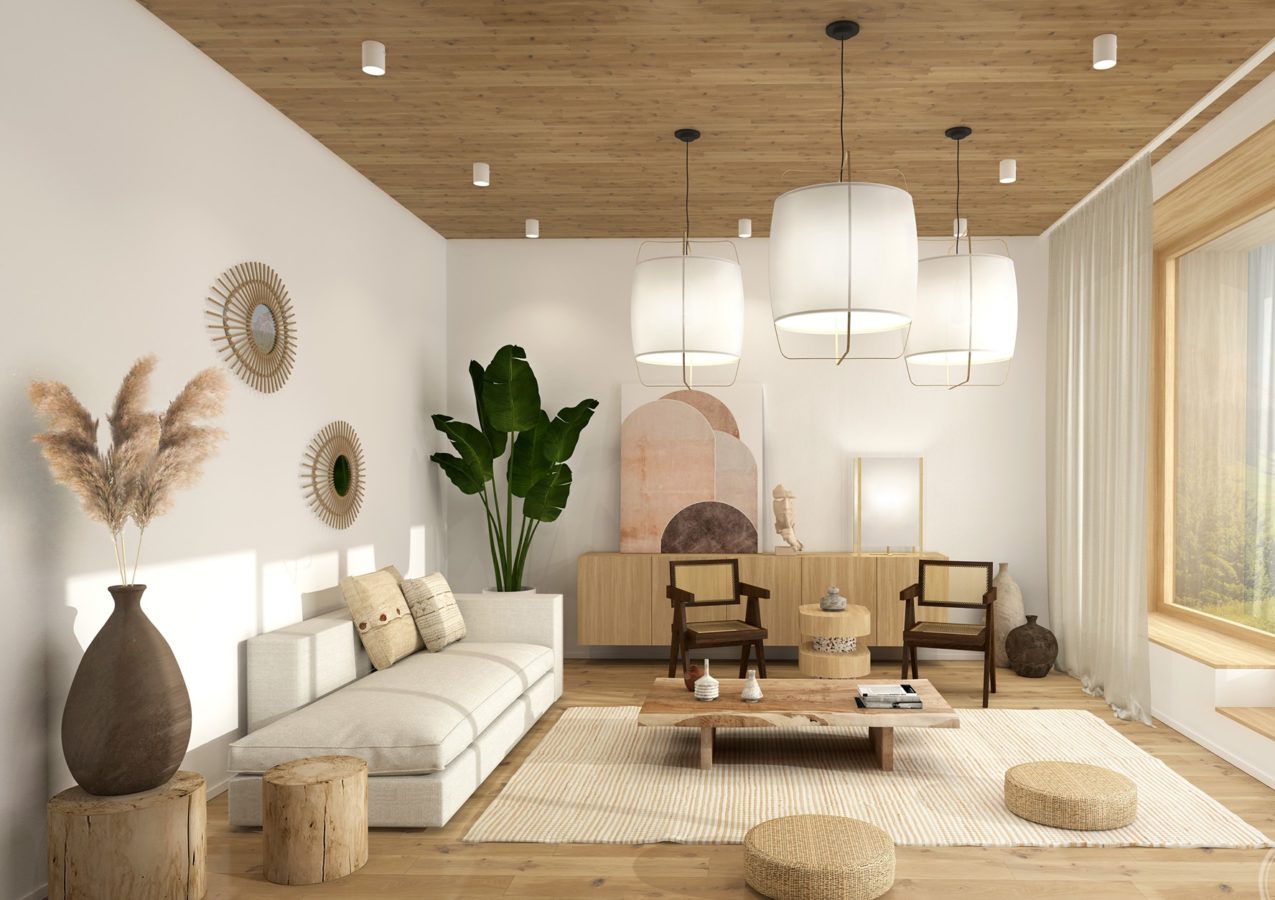
Japandi is the result of a harmonious blend of Japanese calm and Scandinavian cosiness, a thoughtful style characterised by balance, functionality, and quiet beauty. It’s minimal but warm, practical yet soothing.
This design blends the refined craftsmanship of Japanese aesthetics with the natural comfort of Nordic living, creating spaces that feel serene, grounded, and effortlessly stylish. There’s nothing flashy here — just earthy tones, clean lines and a deep appreciation for natural materials, open space, and meaningful design.

Japandi interiors are soothing and slow. Every element has a purpose, and nothing is included without intention. It’s less about decorating and more about curating — a refined sense of simplicity that feels both lived-in and elevated.
Elements | Description |
Palette | Soft, earthy neutrals: warm whites, muted greys, beige, taupe, and charcoal. Occasional accents in black, forest green, or indigo add contrast. |
Materials | Light wood, stone, linen, paper, ceramic, and bamboo. Surfaces are matte, organic, and minimally treated. Craftsmanship and quality matter more than decoration. |
Texture and Shape | Low-profile furniture with clean lines, rounded edges, and minimal ornamentation. Layered textures (woven rugs, linen drapes, clay vessels) add warmth. |
Lighting | Soft, diffused lighting, such as paper lanterns, sculptural fixtures, and ambient floor lamps create a gentle glow. Natural light is maximised and never blocked. |
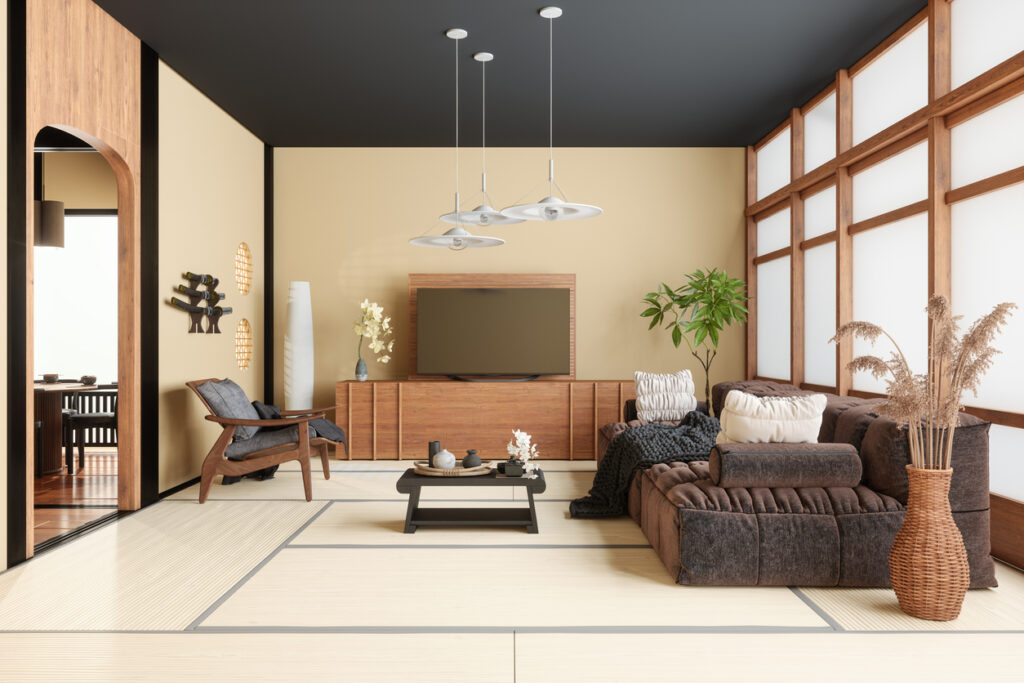
Japandi resonates with those who value calm, clarity, and quality over clutter. It’s perfect for mindful minimalists, design lovers, and anyone seeking a home that encourages slower living and intentional space.
Feeling Stuck with Your Interior Design?
Whether you’re overwhelmed by choices or unsure where to start, creating a home that “feels right” can be harder than it looks. From defining your style to choosing layouts, colours, and furniture, there’s a lot to juggle.
That’s where Studio Pandan, a trusted interior design Selangor, comes in. We take your ideas, floor plan, and budget and turn them into a home that’s intentional, beautiful, and uniquely yours. Whether you need full-service design, material and moodboard guidance, or help styling the final finishing touches, we’ve got you.
Ready to bring your vision to life? Let’s chat and create a space you’ll love to live in.


